#2017 Interior Design Trends
Explore tagged Tumblr posts
Text
How many of you get excited when you see a monarch butterfly? If you do, did you get excited as a kid, or is the excitement a function of their possibly pending extinction? If you do not, can you imagine a world without monarch butterflies?
Excerpt from this story from E&E News/Politico:
Judgment day approaches for the monarch butterfly.
Bound by a court settlement, the Fish and Wildlife Service is supposed to decide by early December whether the monarch warrants listing as threatened or endangered. Although the agency misses many Endangered Species Act deadlines, it appears determined to meet this one after several years of study.
“We wanted to make sure that we have all the best science available … and we wanted to make sure that we were able to gather all that information and make a quality decision,” said Nicole Alt, director of FWS’ Center for Pollinator Conservation.
With the migratory butterfly passing through dozens of states, a decision to list the species could be accompanied by the designation of an expansive critical habitat. Combined with other regulatory implications, this could make the long-delayed monarch listing call one of the most consequential actions in the history of the ESA. It also appears likely, some monarch experts say, given the bleak population trends that led FWS to conclude in 2020 that “monarch viability is declining and is projected to continue declining over the next 60 years.”
Despite the dire circumstances, a campaign to help the monarch butterfly has been advancing on multiple fronts but without a unified commander in chief. Rather, the monarch’s allies march under different flags that reflect a dispersed approach toward species conservation. Some study the insect, some set aside habitat and some tinker with new tools, all without reference to a species recovery plan that an ESA listing would mandate.
Consider:
From an urban office building, a program administered by the University of Illinois, Chicago’s Energy Resources Center has recruited energy companies, state departments of transportation and counties into conserving hundreds of thousands of acres as butterfly habitat on rights of way, such as the medians between roads.
On sprawling Fort Cavazos — formerly Fort Hood — in Texas, biologists prowl the grounds in search of adult monarchs as well as eggs and larva. Since 2017, they estimate they have collected information from more than 10,000 tagged adult monarchs and forwarded this data to another team of collaborators with the Monarch Watch program based at the University of Kansas.
From her Denver office, Alt oversees four geographically scattered FWS staffers and collaborates with others in and out of government. With yet another allied group called Monarch Joint Venture, for instance, the Center for Pollinator Conservation is supporting studies of drones and artificial intelligence in measuring milkweed distribution on wildlife refuges.
And, scattered as they are, the various monarch teams, researchers and advocates periodically gather for a meeting of the minds, as they did in the summer of 2022 for a first-of-its-kind Capitol Hill butterfly summit where Interior Secretary Deb Haaland announced establishment of Alt’s pollinator center.
“It’s really been exciting to see the level of interest from lots of different sectors,” Alt said, adding that “different people want to work in different ways and in different spaces … and in the vast majority of situations they are all advocating for the same thing.”
Some conservation groups, however, want to see a more urgent focus on the problem, saying Congress needs to dramatically increase funding to help the monarchs truly recover. In letters sent last week to House and Senate appropriators, the Center for Biological Diversity and other environmental groups called on lawmakers to provide $100 million annually to restore 1 million acres of pollinator habitat in this country each year and another $30 million to preserve forests in Mexico where some of the butterflies spend their winters.
The groups noted how people over generations have heralded the black-and-orange butterfly’s “spectacular beauty and epic, life-affirming migrations.”
“Dedicating $100 million a year to monarch conservation gives these beloved butterflies a fighting chance at survival,” one letter said.
13 notes
·
View notes
Text
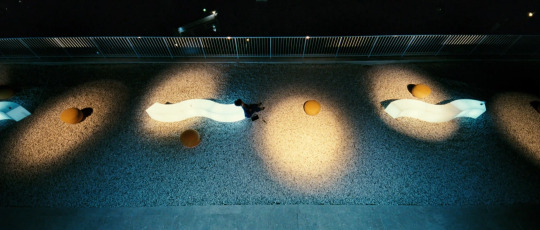
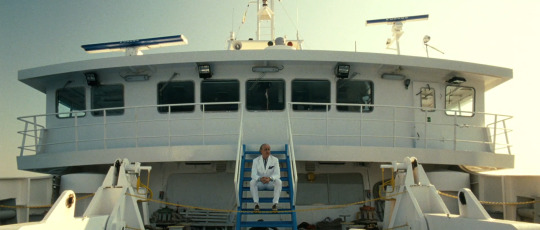
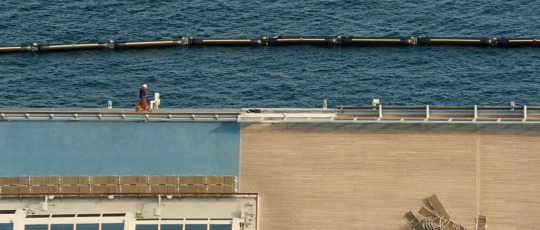
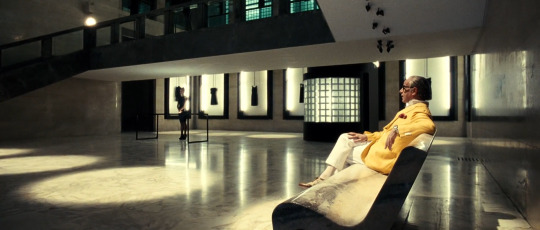

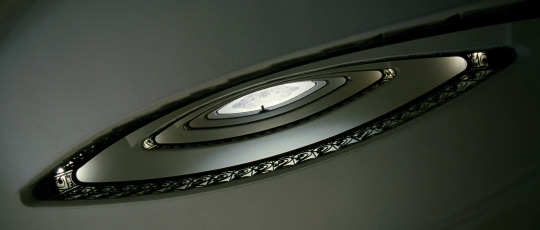
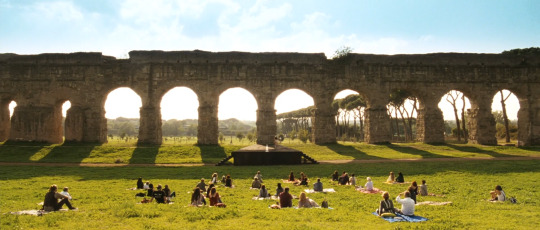
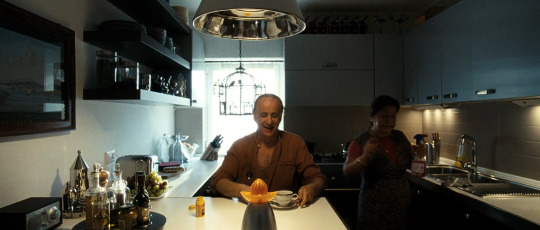
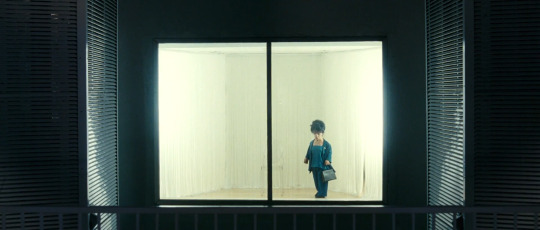
The Great Beauty, focused on the sixty-fifth birthday of a successful journalist and social animal in Rome, is a wonderful film: it presents a cosmopolitan portrait of life, and each image in the film seems well-chosen, for its architecture and interior design, for the presentation of nature and scene and visual art, for the location and placement of persons and movement. The central character among many eccentric characters, the journalist Jep Gambardella is smart and suave, a libertine who is too self-aware and honest to be self-infatuated or proud, and too generous to be cynical. Jep Gambardella (actor Toni Servillo) is a wonderfully believable and likable character. His life has been easy (his friends are rich, and he has a grand apartment, and the women are still attracted to him), but that has been part of his problem: Jep has not had to demand much of himself. The motion picture is full of personalities and their smart talk, and it presents diverse stories, different lives, with their comedy and drama. The Great Beauty could be a continuation of the work of great film directors such as Visconti, Fellini, and Bertolucci, men who created photoplays of grandeur and history, strangeness and truth. The importance of consciousness, personal choice, public discourse, art, money, and politics are the content of the conversations, conversations that are serious and also distractions from private dilemmas—a second book that was never written; a husband in love with someone else; a disturbed, suicidal son. The film allows meditation on modern existence, on the complexities and idiosyncrasies of modern contemporary life in great cities: the personal liberties and odd loneliness, and collisions of past and present, prominent industries, celebrity culture, jazz, cocaine, botox parties, and indulgent sexuality. by Daniel Garrett Volume 21, Issue 8 / August 2017
The film is an examination of potential unfulfilled and squandered, with the pursuit of momentary pleasures a salve against deeper wounds. It mixes a phantasmagoric, oblique critique of the excesses of Italy’s recent past under former Prime Minister Silvio Berlusconi with an affectionate unstated tribute to the peculiar, exuberant imagery of Italy’s cinematic maestro, Federico Fellini.
Sorrentino acknowledged that the outsized gestures of his visual style — as also demonstrated in his vividly dense 2008 film “Il Divo,” which starred Servillo as seven-time Italian Prime Minister Giulio Andreotti — are out of step with trends on the international art house circuit. And he doesn’t mind a bit. - By Mark Olsen
5 notes
·
View notes
Text
Arts and media
Actorm, Western Star, Silver Screen, Between Take, Hooray for Hollywood, Artist, Ballerina, Cake baker, Chef, Bakery chef (2018)[39],Cookie chef (2014)[40], Cupcake chef (2015)[41], Dessert chef (2013)[42], Pancake chef (2012)[43], Pasta chef (2021)[44], Pastry chef (clothing pack 2014)[45], Pizza chef (2009)[28], Smoothie chef (2016)[46], Spaghetti chef (2017)[47], Sweet chef (2013)[48]
TV chef (2009)[49]
Circus performer (1995,[50] 2010[51])
Dancer (2011[52])
Ballroom dancer (1991,[53] 2014[54])
Cabaret dancer (2007[55])
Can-can dancer (2009,[56] 2011[57])
Rockette (1992[58])
Showgirl (2008[20])
Fashion designer (1960,[59]: 2 re-released 1995;[60] clothing pack 1992,[61] 2001,[62] 2002,[63] 2012,[64] clothing pack 2015[65])
Fashion editor (1965,[66] 2000[67])
Fashion model (1959,[68] Fashion Model Collection 2000–2020,[20][69] Top Model 2008,[70] I can be... Fashion Model 2012[71])
Fashion trend forecaster (1999[72])
Film director (2015[73])
Film producer (2005[59]: 48 )
Floral designer (2012[74])
Game show host (1987[75])
Interior designer (2022[76])
Make-up artist (Barbie loves MAC 2007,[77] I can be... Makeup Artist 2013[78])
Musician (2017,[79] 2019,[80] clothing pack 2020[81])
Bard (2004[82])
Lute player (Japan-exclusive Barbie Styled by Yuming 2000[83])
Pianist (playset 1989[84])
Rock star/guitarist (1986,[85] Barbie and the Beat 1989,[86] 1998,[87] 1999,[88] 2010,[89] 2013,[90] 2015[91])
Saxophonist (clothing pack 2018[92])
Violinist (2013,[93] clothing pack 2021[94])
Music producer (2021[95])
News anchor (2010,[96] 2019[97])
Photographer
Baby photographer (2008[98])
Fashion photographer (2012[99])
Pet photographer (2022[100])
Photojournalist (2019, collaboration with National Geographic[101])
Rapper (1992[102])
Singer (Solo in the Spotlight 1960,[103] re-released 1990 and 1995;[104][103] Barbie and the Rockers 1986,[105] Japan-exclusive 1987,[83] Barbie and the Sensations 1988,[106] Bandstand Beauty 1996,[107] 2002,[108] 2013[109])
Country Western singer (Country Western Star 1994,[110] Country Rose 1997,[111] Rising Star 1998,[112] 1999[113])
Jazz singer (2007[114])
Lounge singer (2006[115])
Pop singer (Pop Sensation 2002,[116] Pop Icon 2010,[117] Pop Star 2019[118])
TV news camerawoman (2018[119])
Business
Edit
Avon representative (1999[120])
Babysitter (accessories only 1963,[121] accessories only 1976,[122] 2010,[123] 2013,[124] 2014,[125] 2015[126])
Bake shop worker (Japan-exclusive 1998, 2006[83])
Business executive (clothing pack 1959,[127] Career Girl 1963, re-released 2006;[128][129] Day to Night 1985, re-released 2018;[130][131] 1992,[87] Working Woman 1999,[132] clothing pack 2020[133])
Café worker (playset 1998[134])
Candy and ice cream parlor worker (1988[135])
Cashier
McDonald's cashier (playset 1982,[136] playset 1994,[137] 2001[138])
Pizza Hut cashier (playset 2001[139])
See's Candies cashier (1999[140])
Supermarket cashier (playset 1992[141])
Chief Sustainability Officer (2022[142])
Coffee shop worker (2020[143])
Crepe shop worker (Japan-exclusive 1987[83])
Department store worker
Makeup department worker (playset only 1982[144])
Fashion department worker (playset only 1982[145])
Entrepreneur (2014[146])
Farmer (2018[147])
Chicken farmer (2019[148])
Florist (1999,[149] 2021[150])
Food truck operator (2020[151])
Grocery store worker (2018[152])
Hair stylist (2014,[153] 2015,[154] 2021[155])
Ice cream cart owner (1987[156])
Ice cream shop worker (1989,[157] playset 1998,[158] 2022[159])
Mary Kay consultant (2003[160])
Noodle bar worker (2020[161])
Outdoor beauty store worker (Canada-exclusive 1999, 2002[83])
Palmer's clothing store employee (Austria-exclusive 1996[162])
Pet boutique owner (2008[163])
Pet groomer (playset 1994,[164] 2013,[165] clothing pack 2020[166])
Restaurant owner (Japan-exclusive 1990,[83] 2021[167])
Shopkeeper (Pioneer Shopkeeper 1996[168])
Secretary (2007[169])
Snack stand worker (playset 1992[170])
Waitress (2006,[20] clothing pack 2012,[171] 2017[172])
Soda fountain waitress (Coca Cola Series 1998[173])
Education
Edit
Art teacher (2002,[174] 2007,[175] 2011,[176] clothing pack 2013,[177] 2020[178])
Ballet teacher (2007,[179] 2010,[180] 2017[181])
Cooking teacher (2010[182])
English language teacher (2017[183])
Music teacher (clothing pack 2012,[184] 2014,[185] 2019[186])
School teacher (India-exclusive 1991,[187] clothing pack 1993,[188] 2006,[20] My Favorite Career 2010,[189] 2019,[190] clothing pack 2021[191])
Elementary school teacher (1995,[192] 1997,[193] 2000,[194] 2007,[195] 2008,[196] 2010,[197] 2011,[198] 2012,[199] 2013,[200] 2015,[201] 2018[202])
Preschool teacher (playset 1997,[203] 2009,[204] I can be... Nursery School Teacher 2012[205])
Sign language teacher (1999[206])
Spanish language teacher (2000[207])
Student teacher (1965,[68] re-issued 2009[208])
Yoga teacher (2012[209])
Medicine
Edit
Animal rescuer (2016[210])
Arctic animal rescuer (2012[211])
Marine wildlife rescuer (2013[212])
Dentist (1997,[87] 2003,[213] 2010,[214] 2015,[215] 2019[216])
Doctor (1988,[217] 1993,[218] Spain-exclusive José Carreras Doctora Barbie 1995,[83] 1996,[219] 2010,[220] 2012,[221] 2013,[222] 2015,[223] 2019[224])
Eye doctor (2015,[225] 2017[226])
Nurse (1961,[227] re-issued 2009.[228] Civil War Nurse 1995,[229] 2006,[230] My Favorite Career 2010,[189] clothing pack 2011,[231] 2012,[232] 2014,[233] clothing pack 2015,[65] 2017[234])
Paramedic (2021[235])
Pediatrician (1995,[236] playset 1996,[237] Children's Doctor 2000,[238] Baby Doctor 2001,[239] Happy Family Baby Doctor 2003,[240] Play All Day Baby Doctor 2006,[241] I can be... Baby Doctor 2008,[242] I can be... Kid Doctor 2010,[243] I can be... Pediatric Doctor 2011,[244] 2013,[245] 2015,[246] 2016[247])
Surgeon (1973, re-released 2021[248])
Veterinarian (1985,[85] Brazil-exclusive 1992,[83] clothing pack 1993,[188] Pet Doctor 1996,[59]: 41 Pet Doctor 2005,[249] Play All Day Zoo Doctor 2006,[250] I can be... Zoo Doctor 2008,[251] I can be... Pony Doctor 2010,[252] I can be... Pet Vet 2012,[253] Panda Caretaker 2014,[254] Zoo Doctor 2015,[255] Farm Vet 2016,[256] 2021[257])
Military
Edit
Army medic (1993[87])
Paratrooper (2000[258])
United States Air Force pilot (1991,[59]: 32 2001[259])
United States Air Force Thunderbirds pilot (1993[260])
United States Army officer (1989,[261] Desert Storm 1992[262])
United States Marine Corps sergeant (1991[87])
United States Navy petty officer QM1 (1991[87])
Political
Edit
Campaign fundraiser (2020[263])
Campaign manager (2020[263])
UNICEF Ambassador (1989[1])
United States Presidential candidate (1992, 2000, 2004, 2008, 2012, 2016[264])
Vice presidential candidate (2016[265])
Public service
Edit
Canadian Mountie (1987,[266] 2013[267])
Detective (1999,[268] 2014[269])
Firefighter (clothing pack 1993,[188] 1995,[87] clothing pack 2011,[270] 2015[271][272])
Judge (2019[273])
Lifeguard (Baywatch 1994,[274] 2011,[275] clothing pack 2014,[276] 2015,[277] 2021[278])
Park ranger (2020[279])
Police officer (1993,[87] clothing pack 2011[270])
Science and engineering
Edit
Architect (2010[280])
Astronaut (1965,[68] 1985,[281] 1994,[282] clothing pack 1997,[283] My Favorite Career 2010,[189] clothing pack 2012,[284] I can be... Mars Explorer 2013,[285] clothing pack 2014,[286] 2017[287])
Astrophysicist (2019, collaboration with National Geographic[288])
Chemist (2018[289][290])
Computer engineer (Computer Engineer Barbie, 2010), (accompanying book pulled by Mattel in 2014[291])
Conservation scientist (2022[142])
Entomologist (2019, collaboration with National Geographic[292][293])
Game developer (2016[294])
Marine biologist (clothing pack 2012[295])
Polar marine biologist (2019, collaboration with National Geographic[101])
Microbiologist (2022[296])
Renewable energy engineer (2022[142])
Robotics engineer (2018[297][298])
Paleontologist (1996,[219] 2012[299])
SeaWorld trainer (2009,[28] 2013[300])
Space scientist (2017[287])
Wildlife conservationist (2019, collaboration with National Geographic[101])
Zoologist (2021[301])
Sports and athletics
Edit
Aerobics instructor (1984[85])
Baseball player (1993,[302] 2018[303])
Major League Baseball player (1998[59]: 44 )
Basketball player (2018[304])
National Basketball Association player (1998[305][306])
Women's National Basketball Association player (1998[307])
Bowler (2000[308])
Boxer (2020[309])
Cheerleader (1963,[310] clothing pack 1964,[311] clothing pack 1992,[312] Coca-Cola Cheerleader 2000,[313] Pom Pom Divas 2006,[314] Dallas Cowboys Cheerleader Barbie 2007,[315] 2010,[316] clothing pack 2011,[317] 2013,[318] 2014[319])
Equestrienne (1976,[320] clothing pack 2010[321])
Figure skater (1990,[322] 1996,[323] 2000,[324] clothing pack 2011,[325] 2012,[326] clothing pack 2014,[327] 2015,[328] clothing pack 2021[329])
Figure skating coach (2019[330])
Golfer (clothing pack 2018[331])
Gymnast (1993,[332] clothing pack 2011,[270] 2012,[333] 2015[334])
Gymnastics coach (2009,[335] 2013,[336] 2016,[337] 2019[338])
Hockey player (Tim Hortons 2020,[339] 2021[340])
Martial artist (clothing pack 2012,[341] 2017[342])
Matador (1999[343])
Olympic athlete
Olympic climber (2020[344])
Olympic figure skater (1975,[345] 1988,[346] 1997,[347] 2002[348])
Olympic gymnast (1974,[349] 1995[350])
Olympic karate (2020[344])
Olympic skateboarder (2020[344])
Olympic skier (1975[59]: 21 )
Olympic softball player (2020[344])
Olympic surfer (2020[344])
Olympic swimmer (1975, re-released 2021;[351][352] Australia-exclusive 1977,[83] 2000[353])
Rhythmic gymnast (2017[354])
Scuba diver (1994[59]: 37 )
Skateboarder (2017[355])
Skier (2011,[356] 2012[357])
Para alpine skier (2022[358])
Snowboarder (2012,[359] 2022[360])
Soccer coach (2019[361])
Soccer player (1998,[362] Italy-exclusive A.C. Milan/Inter Milan 1999,[363] 2011,[364] 2013,[365] 2014,[366] 2015,[367] 2022[368])
Swimmer (2012[369])
Swim teacher (2008[370])
Tennis coach (2017[371])
Tennis player (European Sports Star 1979,[372] clothing pack 1997,[373] 2012,[357] 2014,[374] 2020,[375] clothing pack 2022[376])
Track-and-field runner (2012[377])
Volleyball coach (2017[378])
Volleyball player, Aircraft engineer (2019[380]), Carriage driver (1998[381]), Flight attendant (American Airlines 1961–64,[382] Pan Am 1966,[383] United Airlines clothing pack 1973,[384] Japan-exclusive Japan Airlines 1997,[385] 2006,[386] My Favorite Career 2010,[189] clothing pack 2011,[270] 2012,[387] Virgin Atlantic 2019[380]), Pilot (Flight Time 1989,[388] India-exclusive Flight Time 1995,[83] 1997,[389] Airline Pilot 1999,[87] clothing pack 2011,[270] 2012,[390] 2014,[391] 2015,[392] 2019,[393][380] clothing pack 2021[394]), Race car driver (2010[395]), Formula One driver (Scuderia Ferrari 2000[396]), NASCAR driver (1998,[59]: 45 1999[397], Tour guide (Toy Story 2 Tour Guide Special Edition 1999[398]), African safari guide (clothing pack 1995[26]), Train conductor (Travel Train Fun 2001[399]), Train hostess (Travel Train Fun 2001[399]), Travel agent (playset 1986[400]), Bee keeper (2018[401]), Candy striper (clothing pack 1964[402]), Cat burglar (Barbie by Christian Louboutin 2009[403]), Construction worker (clothing pack 2020[404]), Cowgirl (1997,[405] 2004[406]), Dolphin trainer (2013[407]), Drum majorette (1964,[408] 2002[409]), Jillaroo (1993[410]), Magician (2013[411]), Maid (Japan-exclusive 1987,[83] 2006[412]), Spy (Mystery Squad 2002,[413] Spy Squad 2015[414]), Starfleet security officer (1996[415]), Superhero (Flying Hero 1995[416]), Ocean treasure explorer (2013[417]), Usher (2007[20]), Wild animal trainer (clothing pack 2010[418]),Wilderness guide (2021[419]), Zookeeper (2013[420])
Guy who hears about any career and says “oh like Barbie”
82K notes
·
View notes
Text
Global Architectural Acoustic Panels Market Poised for Growth Amid Rising Demand for Soundproofing Solutions Post-COVID
Global Architectural Acoustic Panels Market Poised for Growth Amid Rising Demand for Soundproofing Solutions Post-COVID
Market Overview
The Global Architectural Acoustic Panels Market has experienced significant growth, particularly in the wake of the COVID-19 pandemic, as industries prioritize noise reduction, enhanced workspace environments, and improved building acoustics. With the increasing need for soundproofing solutions in commercial, residential, and industrial spaces, architectural acoustic panels have gained traction in sectors such as corporate offices, healthcare, educational institutions, hospitality, and entertainment.
The pandemic triggered a transformation in workplace design, with organizations investing in quieter office spaces, home-based work environments, and acoustic-friendly interiors. Additionally, urbanization, smart building initiatives, and stringent noise pollution regulations are further propelling the demand for architectural acoustic panels globally.
Free Sample Report:- Sample Request | (COVID Version) Global Architectural Acoustic Panels Market Status (2017-2022) And Forecast (2022E-2028F) By Region, Product Type & End-Use
Market Insights & Trends
Post-Pandemic Focus on Health & Productivity: Companies are integrating soundproofing solutions into office spaces to enhance productivity and employee well-being, reducing distractions caused by excessive noise.
Growing Adoption in Residential & Home Offices: With the rise of remote work and hybrid office models, homeowners are increasingly investing in acoustic panel installations to create noise-free work environments.
Sustainability-Driven Innovations: The market is witnessing the development of eco-friendly acoustic panels made from recycled, biodegradable, and low-emission materials, aligning with global sustainability goals.
Advancements in Smart Acoustics: Integration of IoT-based and AI-powered acoustic solutions is enhancing sound absorption, real-time noise control, and energy-efficient designs.
Expansion in Entertainment & Hospitality Sectors: The increasing number of theaters, recording studios, hotels, and restaurants adopting advanced acoustic paneling to enhance customer experiences is driving demand.
Key Players in the Market
The Global Architectural Acoustic Panels Market is highly competitive, with major players investing in sustainable materials, advanced acoustic technologies, and innovative panel designs. Leading companies include:
Saint-Gobain
Armstrong World Industries, Inc.
Hunter Douglas
Knauf Insulation
Rockwool International A/S
USG Corporation
Burgeree Acoustics Technology
Abstracta
G&S Acoustics
Acoustical Surfaces, Inc.
These companies are actively developing customized solutions, lightweight soundproofing materials, and AI-integrated acoustic panels to cater to diverse industrial and commercial applications.
Full Report:- (COVID Version) Global Architectural Acoustic Panels Market Status (2017-2022) And Forecast (2022E-2028F) By Region, Product Type & End-Use
Regional Insights
North America: The United States and Canada are leading the market, driven by increased investments in commercial infrastructure, open-office designs, and smart building technologies.
Europe: Countries such as Germany, the UK, and France are implementing strict noise control regulations, promoting the adoption of high-performance acoustic panels in construction and industrial applications.
Asia-Pacific: China, Japan, and India are experiencing rapid urbanization, with growing demand for acoustic panel solutions in residential buildings, corporate offices, and entertainment hubs.
South America, Middle East & Africa: The rising number of hotels, conference centers, and luxury residential projects is fueling market growth in these regions.
Market Outlook & Growth Prospects
The Global Architectural Acoustic Panels Market is projected to grow at a CAGR of over 6% through 2028, driven by:
Rising demand for noise control solutions in commercial and residential spaces
Integration of smart acoustic technologies and AI-based soundproofing
Increased investments in eco-friendly and sustainable building materials
Expansion of entertainment, hospitality, and co-working office spaces
Strict regulatory policies for workplace noise reduction and building acoustics
Enquire Before Buy:- Enquire Before Buy | (COVID Version) Global Architectural Acoustic Panels Market Status (2017-2022) And Forecast (2022E-2028F) By Region, Product Type & End-Use
Conclusion
The Global Architectural Acoustic Panels Market is set for continued expansion, with businesses, architects, and homeowners increasingly recognizing the value of soundproofing and acoustical enhancements in modern infrastructure. As technological advancements, sustainability initiatives, and workplace trends drive market demand, acoustic panel solutions will play a crucial role in future commercial and residential building designs.
Top Trending Reports
Global More Electric Aircraft Market
Nigeria Oil and Gas Upstream Activities Market
Global Industrial Plastic Bags Market
Global Palladium Market
0 notes
Photo
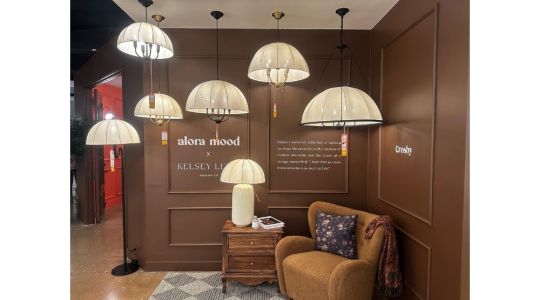
Alora introduced the Alora Mood X Kelsey Leigh collection, featuring the softened looks prevalent at Lightovation 2025. DALLAS — Many lighting manufacturers came to Lightovation earlier this month with a more practical, realistic mindset, acknowledging with their product intros that in 2025, many consumers may not have a big budget for lighting nor a grand space in which to install it. They are therefore paying more attention to smaller spaces, renters and affordable lighting options with design-forward pieces that rival their larger and more expensive cousins. In addition, the humble ceiling fan seems to be having a bit of a resurgence, and outdoor lighting options increased. If the Trump administration’s proposed tariffs become reality, lighting prices will increase, said Jeff Dross. Dross, an industry expert who was a corporate director of education and industry trends at Kichler Lighting for over 46 years, spoke during an American Society of Interior Designers (ASID) panel discussion during market. An ASID panel discussion covered trending topics in lighting. This is something most vendors have acknowledged since the issue of tariffs was first raised during the presidential campaign last year. Many of them pointed out that almost every company in the industry will be forced to raise prices and thus no one manufacturer will stand out. Dross, however, noted that “something will have to give” and manufacturers may find themselves less able to support their retail partners with things like product images and other assets, or may have to take more drastic steps such as reducing staff, relocating their business to a more affordable location or moving to smaller buildings. In the same panel discussion, Kirsten Recce of Black Whale Home in Encinitas, Calif., noted that the industry is still sitting on the 25% increase that results from the 2017 tariffs. “Lighting prices have essentially doubled in the past eight years,” Recce said. “On the lighting showroom side, I’m not seeing the budget for lighting that I used to see. I am seeing a saturation point … it’s getting harder and harder to sell high-end lighting. It’s the more value-oriented lines [that are selling.] “Both the lighting designer and the retail customer is stepping down.” Smaller spaces Perhaps with that in mind, manufacturers are paying more attention to smaller living spaces and apartment rentals (albeit higher-end apartment rentals) with lighting that can plug in — versus having to be hardwired — and trend-forward semi-flush and flush-mounts that are ideal for the 8- and 10-foot ceilings more commonly found in older homes and apartments. Knowing that consumer budgets are likely to dictate lighting choices this year, some vendors suggested that interior designers and end consumers could highlight one higher-end fixture in the most prominent or visited room in a home and use more budget-friendly choices that complement the higher-end fixture in the less-used or less-seen rooms. This also takes into consideration that consumers often only consider lighting with their leftover money, after all other room renovations are done. There was also a resurgent focus among manufacturers in ceiling fans, with more options from Maxim Lighting and Kuzco, among others, and a continued large offering from WAC Lighting and Progress Lighting, among others. Alex Ostrovsky, director of sales and product management for WAC Group, said the company was trying to get interior designers to better appreciate ceiling fans with models that are sleek and subtle, disappear into the space and “don’t clutter the ceiling.” Its carved balsa wood fans have been a popular sub-category of fans for the past four or five years, he said. Michael Poole of Visual Comfort shows off the Plank ceiling fan. At Visual Comfort, fans “have to perform and be beautiful,” said Michael Poole, senior manager for design partnerships and a former product developer. “The motor has to be powerful, sleek, quiet and move air. We invest in all those things.” Outdoor lighting Outdoor lighting designs also had their place in the spotlight at Lightovation. Industry newcomer Alteck Lighting made its Lightovation debut with a large assortment of outdoor styles with color-changing capability in a range of materials, all of which are 100% wet-location rated, according to Colleen Visage, chief operating officer. Alteck’s Eclipse flush mount, left, and the Raymond sconce Hubbardton Forge offered its take on traditional outdoor designs with a new shepherd’s hook-style lantern and one that had a cloche-like cover, rather than the panel-sided design. Many pieces in its outdoor assortment are Dark Sky-friendly, with no upward “escape” of light. Troy Lighting, part of the Hudson Valley Lighting Group, featured damp-rated rechargeable outdoor lanterns, its first foray into the outdoor cordless lamp category. Kichler, some of whose products were featured in its new corporate sister Progress Lighting’s showroom, has an Landscape Lighting Lab in its Experience Center in Dallas. Maxim noted its proprietary and patented Vivex material, which can withstand salt water, heat and cold, making it appropriate for coastal environments. It has a three-year limited warranty. Design direction “Softening” was the term most frequently used to describe an emerging design aesthetic, a blurring of style lines that makes looks more broadly appealing. So, contemporary or modern designs are softened using things like fabric shades, opaque glass or more classic elements, such as paneled sides or parasol shapes. The bare bulb era seems to be over. Bulbs took a backseat to shades which are milky, swirled and made of opaque white glass. There were more linen or fabric shades spotted at this show, more ribbed and fluted glass shades, and more diffusers. Natural materials like rattan have become a mainstay, and light-colored woods are on the rise, matching current looks in flooring and cabinetry, some vendors noted. The Ellen DeGeneres Hikari linen pendant from Visual Comfort’s Studio line, left, and Lisa McDennon’s fringed Baya pendant from Hinkley There is a need for color, retailer Recce said. “Every shelter magazine is screaming color, and our industry has never had less color,” she said. There were touches here and there, including art glass pendants from Fine Art Handcrafted Lighting, Crystorama and Maxim Lighting, as well as colorful metal pendants with neutral undertones from Kuzco. Among the more interesting materials and material combinations at market was Maxim’s pendants designed by Ryan Saghian and made from perforated metal dipped in plaster and paired with travertine. !function(f,b,e,v,n,t,s) if(f.fbq)return;n=f.fbq=function()n.callMethod? n.callMethod.apply(n,arguments):n.queue.push(arguments); if(!f._fbq)f._fbq=n;n.push=n;n.loaded=!0;n.version='2.0'; n.queue=[];t=b.createElement(e);t.async=!0; t.src=v;s=b.getElementsByTagName(e)[0]; s.parentNode.insertBefore(t,s)(window, document,'script', ' fbq('init', '693453330863834'); fbq('track', 'PageView'); Source link
#HOME_DECOR#ACCENTS#ALTECK_LIGHTING#ASID#DALLAS#DESIGN#DIRECTIONS#HINKLEY_LIGHTING#HOME#JEFF_DROSS#KICHLER#KUZCO#LIGHTOVATION#MAXIM_LIGHTING#PROGRESS_LIGHTING#TODAY#TROY_LIGHTING#VISUAL_COMFORT#WAC_GROUP
0 notes
Photo
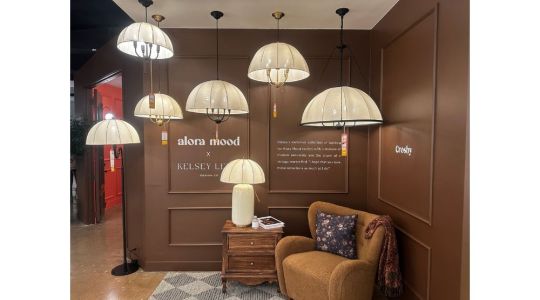
Alora introduced the Alora Mood X Kelsey Leigh collection, featuring the softened looks prevalent at Lightovation 2025. DALLAS — Many lighting manufacturers came to Lightovation earlier this month with a more practical, realistic mindset, acknowledging with their product intros that in 2025, many consumers may not have a big budget for lighting nor a grand space in which to install it. They are therefore paying more attention to smaller spaces, renters and affordable lighting options with design-forward pieces that rival their larger and more expensive cousins. In addition, the humble ceiling fan seems to be having a bit of a resurgence, and outdoor lighting options increased. If the Trump administration’s proposed tariffs become reality, lighting prices will increase, said Jeff Dross. Dross, an industry expert who was a corporate director of education and industry trends at Kichler Lighting for over 46 years, spoke during an American Society of Interior Designers (ASID) panel discussion during market. An ASID panel discussion covered trending topics in lighting. This is something most vendors have acknowledged since the issue of tariffs was first raised during the presidential campaign last year. Many of them pointed out that almost every company in the industry will be forced to raise prices and thus no one manufacturer will stand out. Dross, however, noted that “something will have to give” and manufacturers may find themselves less able to support their retail partners with things like product images and other assets, or may have to take more drastic steps such as reducing staff, relocating their business to a more affordable location or moving to smaller buildings. In the same panel discussion, Kirsten Recce of Black Whale Home in Encinitas, Calif., noted that the industry is still sitting on the 25% increase that results from the 2017 tariffs. “Lighting prices have essentially doubled in the past eight years,” Recce said. “On the lighting showroom side, I’m not seeing the budget for lighting that I used to see. I am seeing a saturation point … it’s getting harder and harder to sell high-end lighting. It’s the more value-oriented lines [that are selling.] “Both the lighting designer and the retail customer is stepping down.” Smaller spaces Perhaps with that in mind, manufacturers are paying more attention to smaller living spaces and apartment rentals (albeit higher-end apartment rentals) with lighting that can plug in — versus having to be hardwired — and trend-forward semi-flush and flush-mounts that are ideal for the 8- and 10-foot ceilings more commonly found in older homes and apartments. Knowing that consumer budgets are likely to dictate lighting choices this year, some vendors suggested that interior designers and end consumers could highlight one higher-end fixture in the most prominent or visited room in a home and use more budget-friendly choices that complement the higher-end fixture in the less-used or less-seen rooms. This also takes into consideration that consumers often only consider lighting with their leftover money, after all other room renovations are done. There was also a resurgent focus among manufacturers in ceiling fans, with more options from Maxim Lighting and Kuzco, among others, and a continued large offering from WAC Lighting and Progress Lighting, among others. Alex Ostrovsky, director of sales and product management for WAC Group, said the company was trying to get interior designers to better appreciate ceiling fans with models that are sleek and subtle, disappear into the space and “don’t clutter the ceiling.” Its carved balsa wood fans have been a popular sub-category of fans for the past four or five years, he said. Michael Poole of Visual Comfort shows off the Plank ceiling fan. At Visual Comfort, fans “have to perform and be beautiful,” said Michael Poole, senior manager for design partnerships and a former product developer. “The motor has to be powerful, sleek, quiet and move air. We invest in all those things.” Outdoor lighting Outdoor lighting designs also had their place in the spotlight at Lightovation. Industry newcomer Alteck Lighting made its Lightovation debut with a large assortment of outdoor styles with color-changing capability in a range of materials, all of which are 100% wet-location rated, according to Colleen Visage, chief operating officer. Alteck’s Eclipse flush mount, left, and the Raymond sconce Hubbardton Forge offered its take on traditional outdoor designs with a new shepherd’s hook-style lantern and one that had a cloche-like cover, rather than the panel-sided design. Many pieces in its outdoor assortment are Dark Sky-friendly, with no upward “escape” of light. Troy Lighting, part of the Hudson Valley Lighting Group, featured damp-rated rechargeable outdoor lanterns, its first foray into the outdoor cordless lamp category. Kichler, some of whose products were featured in its new corporate sister Progress Lighting’s showroom, has an Landscape Lighting Lab in its Experience Center in Dallas. Maxim noted its proprietary and patented Vivex material, which can withstand salt water, heat and cold, making it appropriate for coastal environments. It has a three-year limited warranty. Design direction “Softening” was the term most frequently used to describe an emerging design aesthetic, a blurring of style lines that makes looks more broadly appealing. So, contemporary or modern designs are softened using things like fabric shades, opaque glass or more classic elements, such as paneled sides or parasol shapes. The bare bulb era seems to be over. Bulbs took a backseat to shades which are milky, swirled and made of opaque white glass. There were more linen or fabric shades spotted at this show, more ribbed and fluted glass shades, and more diffusers. Natural materials like rattan have become a mainstay, and light-colored woods are on the rise, matching current looks in flooring and cabinetry, some vendors noted. The Ellen DeGeneres Hikari linen pendant from Visual Comfort’s Studio line, left, and Lisa McDennon’s fringed Baya pendant from Hinkley There is a need for color, retailer Recce said. “Every shelter magazine is screaming color, and our industry has never had less color,” she said. There were touches here and there, including art glass pendants from Fine Art Handcrafted Lighting, Crystorama and Maxim Lighting, as well as colorful metal pendants with neutral undertones from Kuzco. Among the more interesting materials and material combinations at market was Maxim’s pendants designed by Ryan Saghian and made from perforated metal dipped in plaster and paired with travertine. !function(f,b,e,v,n,t,s) if(f.fbq)return;n=f.fbq=function()n.callMethod? n.callMethod.apply(n,arguments):n.queue.push(arguments); if(!f._fbq)f._fbq=n;n.push=n;n.loaded=!0;n.version='2.0'; n.queue=[];t=b.createElement(e);t.async=!0; t.src=v;s=b.getElementsByTagName(e)[0]; s.parentNode.insertBefore(t,s)(window, document,'script', ' fbq('init', '693453330863834'); fbq('track', 'PageView'); Source link
#HOME_DECOR#ACCENTS#ALTECK_LIGHTING#ASID#DALLAS#DESIGN#DIRECTIONS#HINKLEY_LIGHTING#HOME#JEFF_DROSS#KICHLER#KUZCO#LIGHTOVATION#MAXIM_LIGHTING#PROGRESS_LIGHTING#TODAY#TROY_LIGHTING#VISUAL_COMFORT#WAC_GROUP
0 notes
Photo
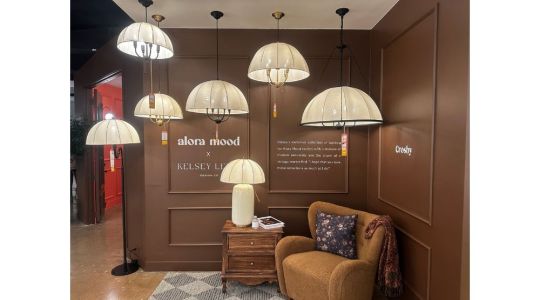
Alora introduced the Alora Mood X Kelsey Leigh collection, featuring the softened looks prevalent at Lightovation 2025. DALLAS — Many lighting manufacturers came to Lightovation earlier this month with a more practical, realistic mindset, acknowledging with their product intros that in 2025, many consumers may not have a big budget for lighting nor a grand space in which to install it. They are therefore paying more attention to smaller spaces, renters and affordable lighting options with design-forward pieces that rival their larger and more expensive cousins. In addition, the humble ceiling fan seems to be having a bit of a resurgence, and outdoor lighting options increased. If the Trump administration’s proposed tariffs become reality, lighting prices will increase, said Jeff Dross. Dross, an industry expert who was a corporate director of education and industry trends at Kichler Lighting for over 46 years, spoke during an American Society of Interior Designers (ASID) panel discussion during market. An ASID panel discussion covered trending topics in lighting. This is something most vendors have acknowledged since the issue of tariffs was first raised during the presidential campaign last year. Many of them pointed out that almost every company in the industry will be forced to raise prices and thus no one manufacturer will stand out. Dross, however, noted that “something will have to give” and manufacturers may find themselves less able to support their retail partners with things like product images and other assets, or may have to take more drastic steps such as reducing staff, relocating their business to a more affordable location or moving to smaller buildings. In the same panel discussion, Kirsten Recce of Black Whale Home in Encinitas, Calif., noted that the industry is still sitting on the 25% increase that results from the 2017 tariffs. “Lighting prices have essentially doubled in the past eight years,” Recce said. “On the lighting showroom side, I’m not seeing the budget for lighting that I used to see. I am seeing a saturation point … it’s getting harder and harder to sell high-end lighting. It’s the more value-oriented lines [that are selling.] “Both the lighting designer and the retail customer is stepping down.” Smaller spaces Perhaps with that in mind, manufacturers are paying more attention to smaller living spaces and apartment rentals (albeit higher-end apartment rentals) with lighting that can plug in — versus having to be hardwired — and trend-forward semi-flush and flush-mounts that are ideal for the 8- and 10-foot ceilings more commonly found in older homes and apartments. Knowing that consumer budgets are likely to dictate lighting choices this year, some vendors suggested that interior designers and end consumers could highlight one higher-end fixture in the most prominent or visited room in a home and use more budget-friendly choices that complement the higher-end fixture in the less-used or less-seen rooms. This also takes into consideration that consumers often only consider lighting with their leftover money, after all other room renovations are done. There was also a resurgent focus among manufacturers in ceiling fans, with more options from Maxim Lighting and Kuzco, among others, and a continued large offering from WAC Lighting and Progress Lighting, among others. Alex Ostrovsky, director of sales and product management for WAC Group, said the company was trying to get interior designers to better appreciate ceiling fans with models that are sleek and subtle, disappear into the space and “don’t clutter the ceiling.” Its carved balsa wood fans have been a popular sub-category of fans for the past four or five years, he said. Michael Poole of Visual Comfort shows off the Plank ceiling fan. At Visual Comfort, fans “have to perform and be beautiful,” said Michael Poole, senior manager for design partnerships and a former product developer. “The motor has to be powerful, sleek, quiet and move air. We invest in all those things.” Outdoor lighting Outdoor lighting designs also had their place in the spotlight at Lightovation. Industry newcomer Alteck Lighting made its Lightovation debut with a large assortment of outdoor styles with color-changing capability in a range of materials, all of which are 100% wet-location rated, according to Colleen Visage, chief operating officer. Alteck’s Eclipse flush mount, left, and the Raymond sconce Hubbardton Forge offered its take on traditional outdoor designs with a new shepherd’s hook-style lantern and one that had a cloche-like cover, rather than the panel-sided design. Many pieces in its outdoor assortment are Dark Sky-friendly, with no upward “escape” of light. Troy Lighting, part of the Hudson Valley Lighting Group, featured damp-rated rechargeable outdoor lanterns, its first foray into the outdoor cordless lamp category. Kichler, some of whose products were featured in its new corporate sister Progress Lighting’s showroom, has an Landscape Lighting Lab in its Experience Center in Dallas. Maxim noted its proprietary and patented Vivex material, which can withstand salt water, heat and cold, making it appropriate for coastal environments. It has a three-year limited warranty. Design direction “Softening” was the term most frequently used to describe an emerging design aesthetic, a blurring of style lines that makes looks more broadly appealing. So, contemporary or modern designs are softened using things like fabric shades, opaque glass or more classic elements, such as paneled sides or parasol shapes. The bare bulb era seems to be over. Bulbs took a backseat to shades which are milky, swirled and made of opaque white glass. There were more linen or fabric shades spotted at this show, more ribbed and fluted glass shades, and more diffusers. Natural materials like rattan have become a mainstay, and light-colored woods are on the rise, matching current looks in flooring and cabinetry, some vendors noted. The Ellen DeGeneres Hikari linen pendant from Visual Comfort’s Studio line, left, and Lisa McDennon’s fringed Baya pendant from Hinkley There is a need for color, retailer Recce said. “Every shelter magazine is screaming color, and our industry has never had less color,” she said. There were touches here and there, including art glass pendants from Fine Art Handcrafted Lighting, Crystorama and Maxim Lighting, as well as colorful metal pendants with neutral undertones from Kuzco. Among the more interesting materials and material combinations at market was Maxim’s pendants designed by Ryan Saghian and made from perforated metal dipped in plaster and paired with travertine. !function(f,b,e,v,n,t,s) if(f.fbq)return;n=f.fbq=function()n.callMethod? n.callMethod.apply(n,arguments):n.queue.push(arguments); if(!f._fbq)f._fbq=n;n.push=n;n.loaded=!0;n.version='2.0'; n.queue=[];t=b.createElement(e);t.async=!0; t.src=v;s=b.getElementsByTagName(e)[0]; s.parentNode.insertBefore(t,s)(window, document,'script', ' fbq('init', '693453330863834'); fbq('track', 'PageView'); Source link
#HOME_DECOR#ACCENTS#ALTECK_LIGHTING#ASID#DALLAS#DESIGN#DIRECTIONS#HINKLEY_LIGHTING#HOME#JEFF_DROSS#KICHLER#KUZCO#LIGHTOVATION#MAXIM_LIGHTING#PROGRESS_LIGHTING#TODAY#TROY_LIGHTING#VISUAL_COMFORT#WAC_GROUP
0 notes
Photo
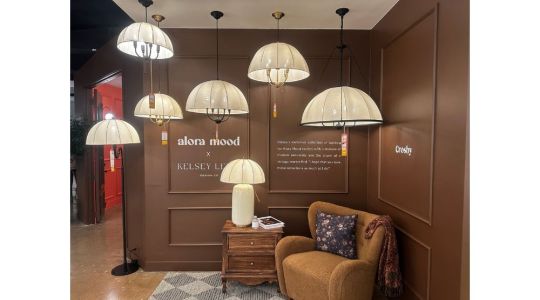
Alora introduced the Alora Mood X Kelsey Leigh collection, featuring the softened looks prevalent at Lightovation 2025. DALLAS — Many lighting manufacturers came to Lightovation earlier this month with a more practical, realistic mindset, acknowledging with their product intros that in 2025, many consumers may not have a big budget for lighting nor a grand space in which to install it. They are therefore paying more attention to smaller spaces, renters and affordable lighting options with design-forward pieces that rival their larger and more expensive cousins. In addition, the humble ceiling fan seems to be having a bit of a resurgence, and outdoor lighting options increased. If the Trump administration’s proposed tariffs become reality, lighting prices will increase, said Jeff Dross. Dross, an industry expert who was a corporate director of education and industry trends at Kichler Lighting for over 46 years, spoke during an American Society of Interior Designers (ASID) panel discussion during market. An ASID panel discussion covered trending topics in lighting. This is something most vendors have acknowledged since the issue of tariffs was first raised during the presidential campaign last year. Many of them pointed out that almost every company in the industry will be forced to raise prices and thus no one manufacturer will stand out. Dross, however, noted that “something will have to give” and manufacturers may find themselves less able to support their retail partners with things like product images and other assets, or may have to take more drastic steps such as reducing staff, relocating their business to a more affordable location or moving to smaller buildings. In the same panel discussion, Kirsten Recce of Black Whale Home in Encinitas, Calif., noted that the industry is still sitting on the 25% increase that results from the 2017 tariffs. “Lighting prices have essentially doubled in the past eight years,” Recce said. “On the lighting showroom side, I’m not seeing the budget for lighting that I used to see. I am seeing a saturation point … it’s getting harder and harder to sell high-end lighting. It’s the more value-oriented lines [that are selling.] “Both the lighting designer and the retail customer is stepping down.” Smaller spaces Perhaps with that in mind, manufacturers are paying more attention to smaller living spaces and apartment rentals (albeit higher-end apartment rentals) with lighting that can plug in — versus having to be hardwired — and trend-forward semi-flush and flush-mounts that are ideal for the 8- and 10-foot ceilings more commonly found in older homes and apartments. Knowing that consumer budgets are likely to dictate lighting choices this year, some vendors suggested that interior designers and end consumers could highlight one higher-end fixture in the most prominent or visited room in a home and use more budget-friendly choices that complement the higher-end fixture in the less-used or less-seen rooms. This also takes into consideration that consumers often only consider lighting with their leftover money, after all other room renovations are done. There was also a resurgent focus among manufacturers in ceiling fans, with more options from Maxim Lighting and Kuzco, among others, and a continued large offering from WAC Lighting and Progress Lighting, among others. Alex Ostrovsky, director of sales and product management for WAC Group, said the company was trying to get interior designers to better appreciate ceiling fans with models that are sleek and subtle, disappear into the space and “don’t clutter the ceiling.” Its carved balsa wood fans have been a popular sub-category of fans for the past four or five years, he said. Michael Poole of Visual Comfort shows off the Plank ceiling fan. At Visual Comfort, fans “have to perform and be beautiful,” said Michael Poole, senior manager for design partnerships and a former product developer. “The motor has to be powerful, sleek, quiet and move air. We invest in all those things.” Outdoor lighting Outdoor lighting designs also had their place in the spotlight at Lightovation. Industry newcomer Alteck Lighting made its Lightovation debut with a large assortment of outdoor styles with color-changing capability in a range of materials, all of which are 100% wet-location rated, according to Colleen Visage, chief operating officer. Alteck’s Eclipse flush mount, left, and the Raymond sconce Hubbardton Forge offered its take on traditional outdoor designs with a new shepherd’s hook-style lantern and one that had a cloche-like cover, rather than the panel-sided design. Many pieces in its outdoor assortment are Dark Sky-friendly, with no upward “escape” of light. Troy Lighting, part of the Hudson Valley Lighting Group, featured damp-rated rechargeable outdoor lanterns, its first foray into the outdoor cordless lamp category. Kichler, some of whose products were featured in its new corporate sister Progress Lighting’s showroom, has an Landscape Lighting Lab in its Experience Center in Dallas. Maxim noted its proprietary and patented Vivex material, which can withstand salt water, heat and cold, making it appropriate for coastal environments. It has a three-year limited warranty. Design direction “Softening” was the term most frequently used to describe an emerging design aesthetic, a blurring of style lines that makes looks more broadly appealing. So, contemporary or modern designs are softened using things like fabric shades, opaque glass or more classic elements, such as paneled sides or parasol shapes. The bare bulb era seems to be over. Bulbs took a backseat to shades which are milky, swirled and made of opaque white glass. There were more linen or fabric shades spotted at this show, more ribbed and fluted glass shades, and more diffusers. Natural materials like rattan have become a mainstay, and light-colored woods are on the rise, matching current looks in flooring and cabinetry, some vendors noted. The Ellen DeGeneres Hikari linen pendant from Visual Comfort’s Studio line, left, and Lisa McDennon’s fringed Baya pendant from Hinkley There is a need for color, retailer Recce said. “Every shelter magazine is screaming color, and our industry has never had less color,” she said. There were touches here and there, including art glass pendants from Fine Art Handcrafted Lighting, Crystorama and Maxim Lighting, as well as colorful metal pendants with neutral undertones from Kuzco. Among the more interesting materials and material combinations at market was Maxim’s pendants designed by Ryan Saghian and made from perforated metal dipped in plaster and paired with travertine. !function(f,b,e,v,n,t,s) if(f.fbq)return;n=f.fbq=function()n.callMethod? n.callMethod.apply(n,arguments):n.queue.push(arguments); if(!f._fbq)f._fbq=n;n.push=n;n.loaded=!0;n.version='2.0'; n.queue=[];t=b.createElement(e);t.async=!0; t.src=v;s=b.getElementsByTagName(e)[0]; s.parentNode.insertBefore(t,s)(window, document,'script', ' fbq('init', '693453330863834'); fbq('track', 'PageView'); Source link
#HOME_DECOR#ACCENTS#ALTECK_LIGHTING#ASID#DALLAS#DESIGN#DIRECTIONS#HINKLEY_LIGHTING#HOME#JEFF_DROSS#KICHLER#KUZCO#LIGHTOVATION#MAXIM_LIGHTING#PROGRESS_LIGHTING#TODAY#TROY_LIGHTING#VISUAL_COMFORT#WAC_GROUP
0 notes
Photo
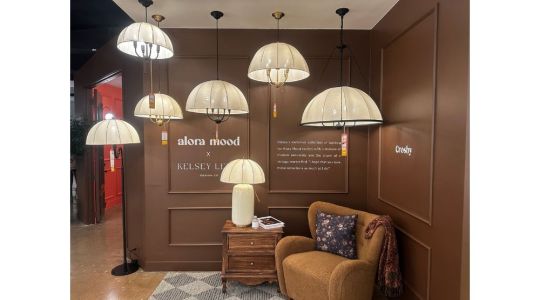
Alora introduced the Alora Mood X Kelsey Leigh collection, featuring the softened looks prevalent at Lightovation 2025. DALLAS — Many lighting manufacturers came to Lightovation earlier this month with a more practical, realistic mindset, acknowledging with their product intros that in 2025, many consumers may not have a big budget for lighting nor a grand space in which to install it. They are therefore paying more attention to smaller spaces, renters and affordable lighting options with design-forward pieces that rival their larger and more expensive cousins. In addition, the humble ceiling fan seems to be having a bit of a resurgence, and outdoor lighting options increased. If the Trump administration’s proposed tariffs become reality, lighting prices will increase, said Jeff Dross. Dross, an industry expert who was a corporate director of education and industry trends at Kichler Lighting for over 46 years, spoke during an American Society of Interior Designers (ASID) panel discussion during market. An ASID panel discussion covered trending topics in lighting. This is something most vendors have acknowledged since the issue of tariffs was first raised during the presidential campaign last year. Many of them pointed out that almost every company in the industry will be forced to raise prices and thus no one manufacturer will stand out. Dross, however, noted that “something will have to give” and manufacturers may find themselves less able to support their retail partners with things like product images and other assets, or may have to take more drastic steps such as reducing staff, relocating their business to a more affordable location or moving to smaller buildings. In the same panel discussion, Kirsten Recce of Black Whale Home in Encinitas, Calif., noted that the industry is still sitting on the 25% increase that results from the 2017 tariffs. “Lighting prices have essentially doubled in the past eight years,” Recce said. “On the lighting showroom side, I’m not seeing the budget for lighting that I used to see. I am seeing a saturation point … it’s getting harder and harder to sell high-end lighting. It’s the more value-oriented lines [that are selling.] “Both the lighting designer and the retail customer is stepping down.” Smaller spaces Perhaps with that in mind, manufacturers are paying more attention to smaller living spaces and apartment rentals (albeit higher-end apartment rentals) with lighting that can plug in — versus having to be hardwired — and trend-forward semi-flush and flush-mounts that are ideal for the 8- and 10-foot ceilings more commonly found in older homes and apartments. Knowing that consumer budgets are likely to dictate lighting choices this year, some vendors suggested that interior designers and end consumers could highlight one higher-end fixture in the most prominent or visited room in a home and use more budget-friendly choices that complement the higher-end fixture in the less-used or less-seen rooms. This also takes into consideration that consumers often only consider lighting with their leftover money, after all other room renovations are done. There was also a resurgent focus among manufacturers in ceiling fans, with more options from Maxim Lighting and Kuzco, among others, and a continued large offering from WAC Lighting and Progress Lighting, among others. Alex Ostrovsky, director of sales and product management for WAC Group, said the company was trying to get interior designers to better appreciate ceiling fans with models that are sleek and subtle, disappear into the space and “don’t clutter the ceiling.” Its carved balsa wood fans have been a popular sub-category of fans for the past four or five years, he said. Michael Poole of Visual Comfort shows off the Plank ceiling fan. At Visual Comfort, fans “have to perform and be beautiful,” said Michael Poole, senior manager for design partnerships and a former product developer. “The motor has to be powerful, sleek, quiet and move air. We invest in all those things.” Outdoor lighting Outdoor lighting designs also had their place in the spotlight at Lightovation. Industry newcomer Alteck Lighting made its Lightovation debut with a large assortment of outdoor styles with color-changing capability in a range of materials, all of which are 100% wet-location rated, according to Colleen Visage, chief operating officer. Alteck’s Eclipse flush mount, left, and the Raymond sconce Hubbardton Forge offered its take on traditional outdoor designs with a new shepherd’s hook-style lantern and one that had a cloche-like cover, rather than the panel-sided design. Many pieces in its outdoor assortment are Dark Sky-friendly, with no upward “escape” of light. Troy Lighting, part of the Hudson Valley Lighting Group, featured damp-rated rechargeable outdoor lanterns, its first foray into the outdoor cordless lamp category. Kichler, some of whose products were featured in its new corporate sister Progress Lighting’s showroom, has an Landscape Lighting Lab in its Experience Center in Dallas. Maxim noted its proprietary and patented Vivex material, which can withstand salt water, heat and cold, making it appropriate for coastal environments. It has a three-year limited warranty. Design direction “Softening” was the term most frequently used to describe an emerging design aesthetic, a blurring of style lines that makes looks more broadly appealing. So, contemporary or modern designs are softened using things like fabric shades, opaque glass or more classic elements, such as paneled sides or parasol shapes. The bare bulb era seems to be over. Bulbs took a backseat to shades which are milky, swirled and made of opaque white glass. There were more linen or fabric shades spotted at this show, more ribbed and fluted glass shades, and more diffusers. Natural materials like rattan have become a mainstay, and light-colored woods are on the rise, matching current looks in flooring and cabinetry, some vendors noted. The Ellen DeGeneres Hikari linen pendant from Visual Comfort’s Studio line, left, and Lisa McDennon’s fringed Baya pendant from Hinkley There is a need for color, retailer Recce said. “Every shelter magazine is screaming color, and our industry has never had less color,” she said. There were touches here and there, including art glass pendants from Fine Art Handcrafted Lighting, Crystorama and Maxim Lighting, as well as colorful metal pendants with neutral undertones from Kuzco. Among the more interesting materials and material combinations at market was Maxim’s pendants designed by Ryan Saghian and made from perforated metal dipped in plaster and paired with travertine. !function(f,b,e,v,n,t,s) if(f.fbq)return;n=f.fbq=function()n.callMethod? n.callMethod.apply(n,arguments):n.queue.push(arguments); if(!f._fbq)f._fbq=n;n.push=n;n.loaded=!0;n.version='2.0'; n.queue=[];t=b.createElement(e);t.async=!0; t.src=v;s=b.getElementsByTagName(e)[0]; s.parentNode.insertBefore(t,s)(window, document,'script', ' fbq('init', '693453330863834'); fbq('track', 'PageView'); Source link
#HOME_DECOR#ACCENTS#ALTECK_LIGHTING#ASID#DALLAS#DESIGN#DIRECTIONS#HINKLEY_LIGHTING#HOME#JEFF_DROSS#KICHLER#KUZCO#LIGHTOVATION#MAXIM_LIGHTING#PROGRESS_LIGHTING#TODAY#TROY_LIGHTING#VISUAL_COMFORT#WAC_GROUP
0 notes
Photo
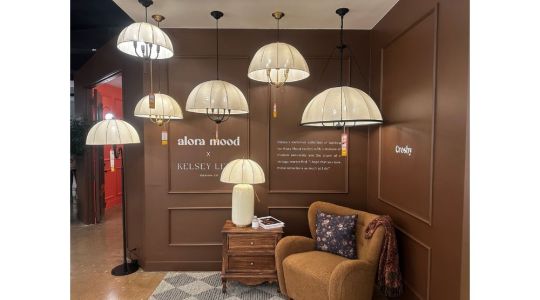
Alora introduced the Alora Mood X Kelsey Leigh collection, featuring the softened looks prevalent at Lightovation 2025. DALLAS — Many lighting manufacturers came to Lightovation earlier this month with a more practical, realistic mindset, acknowledging with their product intros that in 2025, many consumers may not have a big budget for lighting nor a grand space in which to install it. They are therefore paying more attention to smaller spaces, renters and affordable lighting options with design-forward pieces that rival their larger and more expensive cousins. In addition, the humble ceiling fan seems to be having a bit of a resurgence, and outdoor lighting options increased. If the Trump administration’s proposed tariffs become reality, lighting prices will increase, said Jeff Dross. Dross, an industry expert who was a corporate director of education and industry trends at Kichler Lighting for over 46 years, spoke during an American Society of Interior Designers (ASID) panel discussion during market. An ASID panel discussion covered trending topics in lighting. This is something most vendors have acknowledged since the issue of tariffs was first raised during the presidential campaign last year. Many of them pointed out that almost every company in the industry will be forced to raise prices and thus no one manufacturer will stand out. Dross, however, noted that “something will have to give” and manufacturers may find themselves less able to support their retail partners with things like product images and other assets, or may have to take more drastic steps such as reducing staff, relocating their business to a more affordable location or moving to smaller buildings. In the same panel discussion, Kirsten Recce of Black Whale Home in Encinitas, Calif., noted that the industry is still sitting on the 25% increase that results from the 2017 tariffs. “Lighting prices have essentially doubled in the past eight years,” Recce said. “On the lighting showroom side, I’m not seeing the budget for lighting that I used to see. I am seeing a saturation point … it’s getting harder and harder to sell high-end lighting. It’s the more value-oriented lines [that are selling.] “Both the lighting designer and the retail customer is stepping down.” Smaller spaces Perhaps with that in mind, manufacturers are paying more attention to smaller living spaces and apartment rentals (albeit higher-end apartment rentals) with lighting that can plug in — versus having to be hardwired — and trend-forward semi-flush and flush-mounts that are ideal for the 8- and 10-foot ceilings more commonly found in older homes and apartments. Knowing that consumer budgets are likely to dictate lighting choices this year, some vendors suggested that interior designers and end consumers could highlight one higher-end fixture in the most prominent or visited room in a home and use more budget-friendly choices that complement the higher-end fixture in the less-used or less-seen rooms. This also takes into consideration that consumers often only consider lighting with their leftover money, after all other room renovations are done. There was also a resurgent focus among manufacturers in ceiling fans, with more options from Maxim Lighting and Kuzco, among others, and a continued large offering from WAC Lighting and Progress Lighting, among others. Alex Ostrovsky, director of sales and product management for WAC Group, said the company was trying to get interior designers to better appreciate ceiling fans with models that are sleek and subtle, disappear into the space and “don’t clutter the ceiling.” Its carved balsa wood fans have been a popular sub-category of fans for the past four or five years, he said. Michael Poole of Visual Comfort shows off the Plank ceiling fan. At Visual Comfort, fans “have to perform and be beautiful,” said Michael Poole, senior manager for design partnerships and a former product developer. “The motor has to be powerful, sleek, quiet and move air. We invest in all those things.” Outdoor lighting Outdoor lighting designs also had their place in the spotlight at Lightovation. Industry newcomer Alteck Lighting made its Lightovation debut with a large assortment of outdoor styles with color-changing capability in a range of materials, all of which are 100% wet-location rated, according to Colleen Visage, chief operating officer. Alteck’s Eclipse flush mount, left, and the Raymond sconce Hubbardton Forge offered its take on traditional outdoor designs with a new shepherd’s hook-style lantern and one that had a cloche-like cover, rather than the panel-sided design. Many pieces in its outdoor assortment are Dark Sky-friendly, with no upward “escape” of light. Troy Lighting, part of the Hudson Valley Lighting Group, featured damp-rated rechargeable outdoor lanterns, its first foray into the outdoor cordless lamp category. Kichler, some of whose products were featured in its new corporate sister Progress Lighting’s showroom, has an Landscape Lighting Lab in its Experience Center in Dallas. Maxim noted its proprietary and patented Vivex material, which can withstand salt water, heat and cold, making it appropriate for coastal environments. It has a three-year limited warranty. Design direction “Softening” was the term most frequently used to describe an emerging design aesthetic, a blurring of style lines that makes looks more broadly appealing. So, contemporary or modern designs are softened using things like fabric shades, opaque glass or more classic elements, such as paneled sides or parasol shapes. The bare bulb era seems to be over. Bulbs took a backseat to shades which are milky, swirled and made of opaque white glass. There were more linen or fabric shades spotted at this show, more ribbed and fluted glass shades, and more diffusers. Natural materials like rattan have become a mainstay, and light-colored woods are on the rise, matching current looks in flooring and cabinetry, some vendors noted. The Ellen DeGeneres Hikari linen pendant from Visual Comfort’s Studio line, left, and Lisa McDennon’s fringed Baya pendant from Hinkley There is a need for color, retailer Recce said. “Every shelter magazine is screaming color, and our industry has never had less color,” she said. There were touches here and there, including art glass pendants from Fine Art Handcrafted Lighting, Crystorama and Maxim Lighting, as well as colorful metal pendants with neutral undertones from Kuzco. Among the more interesting materials and material combinations at market was Maxim’s pendants designed by Ryan Saghian and made from perforated metal dipped in plaster and paired with travertine. !function(f,b,e,v,n,t,s) if(f.fbq)return;n=f.fbq=function()n.callMethod? n.callMethod.apply(n,arguments):n.queue.push(arguments); if(!f._fbq)f._fbq=n;n.push=n;n.loaded=!0;n.version='2.0'; n.queue=[];t=b.createElement(e);t.async=!0; t.src=v;s=b.getElementsByTagName(e)[0]; s.parentNode.insertBefore(t,s)(window, document,'script', ' fbq('init', '693453330863834'); fbq('track', 'PageView'); Source link
#HOME_DECOR#ACCENTS#ALTECK_LIGHTING#ASID#DALLAS#DESIGN#DIRECTIONS#HINKLEY_LIGHTING#HOME#JEFF_DROSS#KICHLER#KUZCO#LIGHTOVATION#MAXIM_LIGHTING#PROGRESS_LIGHTING#TODAY#TROY_LIGHTING#VISUAL_COMFORT#WAC_GROUP
0 notes
Photo
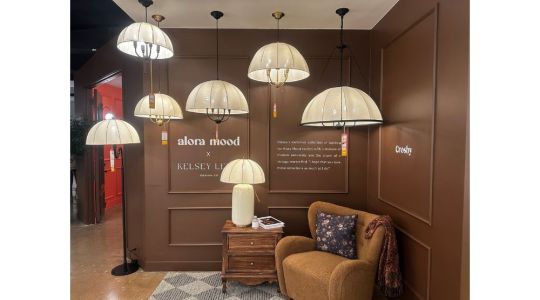
Alora introduced the Alora Mood X Kelsey Leigh collection, featuring the softened looks prevalent at Lightovation 2025. DALLAS — Many lighting manufacturers came to Lightovation earlier this month with a more practical, realistic mindset, acknowledging with their product intros that in 2025, many consumers may not have a big budget for lighting nor a grand space in which to install it. They are therefore paying more attention to smaller spaces, renters and affordable lighting options with design-forward pieces that rival their larger and more expensive cousins. In addition, the humble ceiling fan seems to be having a bit of a resurgence, and outdoor lighting options increased. If the Trump administration’s proposed tariffs become reality, lighting prices will increase, said Jeff Dross. Dross, an industry expert who was a corporate director of education and industry trends at Kichler Lighting for over 46 years, spoke during an American Society of Interior Designers (ASID) panel discussion during market. An ASID panel discussion covered trending topics in lighting. This is something most vendors have acknowledged since the issue of tariffs was first raised during the presidential campaign last year. Many of them pointed out that almost every company in the industry will be forced to raise prices and thus no one manufacturer will stand out. Dross, however, noted that “something will have to give” and manufacturers may find themselves less able to support their retail partners with things like product images and other assets, or may have to take more drastic steps such as reducing staff, relocating their business to a more affordable location or moving to smaller buildings. In the same panel discussion, Kirsten Recce of Black Whale Home in Encinitas, Calif., noted that the industry is still sitting on the 25% increase that results from the 2017 tariffs. “Lighting prices have essentially doubled in the past eight years,” Recce said. “On the lighting showroom side, I’m not seeing the budget for lighting that I used to see. I am seeing a saturation point … it’s getting harder and harder to sell high-end lighting. It’s the more value-oriented lines [that are selling.] “Both the lighting designer and the retail customer is stepping down.” Smaller spaces Perhaps with that in mind, manufacturers are paying more attention to smaller living spaces and apartment rentals (albeit higher-end apartment rentals) with lighting that can plug in — versus having to be hardwired — and trend-forward semi-flush and flush-mounts that are ideal for the 8- and 10-foot ceilings more commonly found in older homes and apartments. Knowing that consumer budgets are likely to dictate lighting choices this year, some vendors suggested that interior designers and end consumers could highlight one higher-end fixture in the most prominent or visited room in a home and use more budget-friendly choices that complement the higher-end fixture in the less-used or less-seen rooms. This also takes into consideration that consumers often only consider lighting with their leftover money, after all other room renovations are done. There was also a resurgent focus among manufacturers in ceiling fans, with more options from Maxim Lighting and Kuzco, among others, and a continued large offering from WAC Lighting and Progress Lighting, among others. Alex Ostrovsky, director of sales and product management for WAC Group, said the company was trying to get interior designers to better appreciate ceiling fans with models that are sleek and subtle, disappear into the space and “don’t clutter the ceiling.” Its carved balsa wood fans have been a popular sub-category of fans for the past four or five years, he said. Michael Poole of Visual Comfort shows off the Plank ceiling fan. At Visual Comfort, fans “have to perform and be beautiful,” said Michael Poole, senior manager for design partnerships and a former product developer. “The motor has to be powerful, sleek, quiet and move air. We invest in all those things.” Outdoor lighting Outdoor lighting designs also had their place in the spotlight at Lightovation. Industry newcomer Alteck Lighting made its Lightovation debut with a large assortment of outdoor styles with color-changing capability in a range of materials, all of which are 100% wet-location rated, according to Colleen Visage, chief operating officer. Alteck’s Eclipse flush mount, left, and the Raymond sconce Hubbardton Forge offered its take on traditional outdoor designs with a new shepherd’s hook-style lantern and one that had a cloche-like cover, rather than the panel-sided design. Many pieces in its outdoor assortment are Dark Sky-friendly, with no upward “escape” of light. Troy Lighting, part of the Hudson Valley Lighting Group, featured damp-rated rechargeable outdoor lanterns, its first foray into the outdoor cordless lamp category. Kichler, some of whose products were featured in its new corporate sister Progress Lighting’s showroom, has an Landscape Lighting Lab in its Experience Center in Dallas. Maxim noted its proprietary and patented Vivex material, which can withstand salt water, heat and cold, making it appropriate for coastal environments. It has a three-year limited warranty. Design direction “Softening” was the term most frequently used to describe an emerging design aesthetic, a blurring of style lines that makes looks more broadly appealing. So, contemporary or modern designs are softened using things like fabric shades, opaque glass or more classic elements, such as paneled sides or parasol shapes. The bare bulb era seems to be over. Bulbs took a backseat to shades which are milky, swirled and made of opaque white glass. There were more linen or fabric shades spotted at this show, more ribbed and fluted glass shades, and more diffusers. Natural materials like rattan have become a mainstay, and light-colored woods are on the rise, matching current looks in flooring and cabinetry, some vendors noted. The Ellen DeGeneres Hikari linen pendant from Visual Comfort’s Studio line, left, and Lisa McDennon’s fringed Baya pendant from Hinkley There is a need for color, retailer Recce said. “Every shelter magazine is screaming color, and our industry has never had less color,” she said. There were touches here and there, including art glass pendants from Fine Art Handcrafted Lighting, Crystorama and Maxim Lighting, as well as colorful metal pendants with neutral undertones from Kuzco. Among the more interesting materials and material combinations at market was Maxim’s pendants designed by Ryan Saghian and made from perforated metal dipped in plaster and paired with travertine. !function(f,b,e,v,n,t,s) if(f.fbq)return;n=f.fbq=function()n.callMethod? n.callMethod.apply(n,arguments):n.queue.push(arguments); if(!f._fbq)f._fbq=n;n.push=n;n.loaded=!0;n.version='2.0'; n.queue=[];t=b.createElement(e);t.async=!0; t.src=v;s=b.getElementsByTagName(e)[0]; s.parentNode.insertBefore(t,s)(window, document,'script', ' fbq('init', '693453330863834'); fbq('track', 'PageView'); Source link
#HOME_DECOR#ACCENTS#ALTECK_LIGHTING#ASID#DALLAS#DESIGN#DIRECTIONS#HINKLEY_LIGHTING#HOME#JEFF_DROSS#KICHLER#KUZCO#LIGHTOVATION#MAXIM_LIGHTING#PROGRESS_LIGHTING#TODAY#TROY_LIGHTING#VISUAL_COMFORT#WAC_GROUP
0 notes
Photo
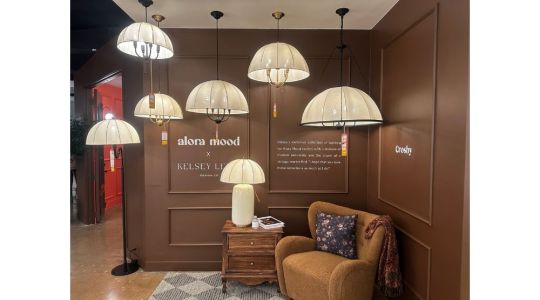
Alora introduced the Alora Mood X Kelsey Leigh collection, featuring the softened looks prevalent at Lightovation 2025. DALLAS — Many lighting manufacturers came to Lightovation earlier this month with a more practical, realistic mindset, acknowledging with their product intros that in 2025, many consumers may not have a big budget for lighting nor a grand space in which to install it. They are therefore paying more attention to smaller spaces, renters and affordable lighting options with design-forward pieces that rival their larger and more expensive cousins. In addition, the humble ceiling fan seems to be having a bit of a resurgence, and outdoor lighting options increased. If the Trump administration’s proposed tariffs become reality, lighting prices will increase, said Jeff Dross. Dross, an industry expert who was a corporate director of education and industry trends at Kichler Lighting for over 46 years, spoke during an American Society of Interior Designers (ASID) panel discussion during market. An ASID panel discussion covered trending topics in lighting. This is something most vendors have acknowledged since the issue of tariffs was first raised during the presidential campaign last year. Many of them pointed out that almost every company in the industry will be forced to raise prices and thus no one manufacturer will stand out. Dross, however, noted that “something will have to give” and manufacturers may find themselves less able to support their retail partners with things like product images and other assets, or may have to take more drastic steps such as reducing staff, relocating their business to a more affordable location or moving to smaller buildings. In the same panel discussion, Kirsten Recce of Black Whale Home in Encinitas, Calif., noted that the industry is still sitting on the 25% increase that results from the 2017 tariffs. “Lighting prices have essentially doubled in the past eight years,” Recce said. “On the lighting showroom side, I’m not seeing the budget for lighting that I used to see. I am seeing a saturation point … it’s getting harder and harder to sell high-end lighting. It’s the more value-oriented lines [that are selling.] “Both the lighting designer and the retail customer is stepping down.” Smaller spaces Perhaps with that in mind, manufacturers are paying more attention to smaller living spaces and apartment rentals (albeit higher-end apartment rentals) with lighting that can plug in — versus having to be hardwired — and trend-forward semi-flush and flush-mounts that are ideal for the 8- and 10-foot ceilings more commonly found in older homes and apartments. Knowing that consumer budgets are likely to dictate lighting choices this year, some vendors suggested that interior designers and end consumers could highlight one higher-end fixture in the most prominent or visited room in a home and use more budget-friendly choices that complement the higher-end fixture in the less-used or less-seen rooms. This also takes into consideration that consumers often only consider lighting with their leftover money, after all other room renovations are done. There was also a resurgent focus among manufacturers in ceiling fans, with more options from Maxim Lighting and Kuzco, among others, and a continued large offering from WAC Lighting and Progress Lighting, among others. Alex Ostrovsky, director of sales and product management for WAC Group, said the company was trying to get interior designers to better appreciate ceiling fans with models that are sleek and subtle, disappear into the space and “don’t clutter the ceiling.” Its carved balsa wood fans have been a popular sub-category of fans for the past four or five years, he said. Michael Poole of Visual Comfort shows off the Plank ceiling fan. At Visual Comfort, fans “have to perform and be beautiful,” said Michael Poole, senior manager for design partnerships and a former product developer. “The motor has to be powerful, sleek, quiet and move air. We invest in all those things.” Outdoor lighting Outdoor lighting designs also had their place in the spotlight at Lightovation. Industry newcomer Alteck Lighting made its Lightovation debut with a large assortment of outdoor styles with color-changing capability in a range of materials, all of which are 100% wet-location rated, according to Colleen Visage, chief operating officer. Alteck’s Eclipse flush mount, left, and the Raymond sconce Hubbardton Forge offered its take on traditional outdoor designs with a new shepherd’s hook-style lantern and one that had a cloche-like cover, rather than the panel-sided design. Many pieces in its outdoor assortment are Dark Sky-friendly, with no upward “escape” of light. Troy Lighting, part of the Hudson Valley Lighting Group, featured damp-rated rechargeable outdoor lanterns, its first foray into the outdoor cordless lamp category. Kichler, some of whose products were featured in its new corporate sister Progress Lighting’s showroom, has an Landscape Lighting Lab in its Experience Center in Dallas. Maxim noted its proprietary and patented Vivex material, which can withstand salt water, heat and cold, making it appropriate for coastal environments. It has a three-year limited warranty. Design direction “Softening” was the term most frequently used to describe an emerging design aesthetic, a blurring of style lines that makes looks more broadly appealing. So, contemporary or modern designs are softened using things like fabric shades, opaque glass or more classic elements, such as paneled sides or parasol shapes. The bare bulb era seems to be over. Bulbs took a backseat to shades which are milky, swirled and made of opaque white glass. There were more linen or fabric shades spotted at this show, more ribbed and fluted glass shades, and more diffusers. Natural materials like rattan have become a mainstay, and light-colored woods are on the rise, matching current looks in flooring and cabinetry, some vendors noted. The Ellen DeGeneres Hikari linen pendant from Visual Comfort’s Studio line, left, and Lisa McDennon’s fringed Baya pendant from Hinkley There is a need for color, retailer Recce said. “Every shelter magazine is screaming color, and our industry has never had less color,” she said. There were touches here and there, including art glass pendants from Fine Art Handcrafted Lighting, Crystorama and Maxim Lighting, as well as colorful metal pendants with neutral undertones from Kuzco. Among the more interesting materials and material combinations at market was Maxim’s pendants designed by Ryan Saghian and made from perforated metal dipped in plaster and paired with travertine. !function(f,b,e,v,n,t,s) if(f.fbq)return;n=f.fbq=function()n.callMethod? n.callMethod.apply(n,arguments):n.queue.push(arguments); if(!f._fbq)f._fbq=n;n.push=n;n.loaded=!0;n.version='2.0'; n.queue=[];t=b.createElement(e);t.async=!0; t.src=v;s=b.getElementsByTagName(e)[0]; s.parentNode.insertBefore(t,s)(window, document,'script', ' fbq('init', '693453330863834'); fbq('track', 'PageView'); Source link
#HOME_DECOR#ACCENTS#ALTECK_LIGHTING#ASID#DALLAS#DESIGN#DIRECTIONS#HINKLEY_LIGHTING#HOME#JEFF_DROSS#KICHLER#KUZCO#LIGHTOVATION#MAXIM_LIGHTING#PROGRESS_LIGHTING#TODAY#TROY_LIGHTING#VISUAL_COMFORT#WAC_GROUP
0 notes
Photo
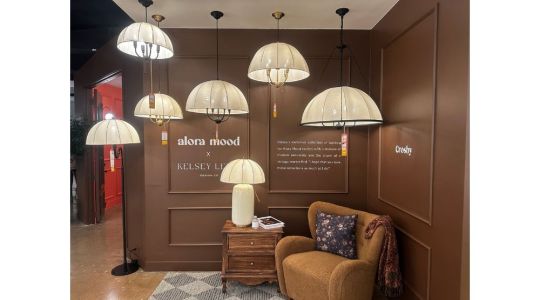
Alora introduced the Alora Mood X Kelsey Leigh collection, featuring the softened looks prevalent at Lightovation 2025. DALLAS — Many lighting manufacturers came to Lightovation earlier this month with a more practical, realistic mindset, acknowledging with their product intros that in 2025, many consumers may not have a big budget for lighting nor a grand space in which to install it. They are therefore paying more attention to smaller spaces, renters and affordable lighting options with design-forward pieces that rival their larger and more expensive cousins. In addition, the humble ceiling fan seems to be having a bit of a resurgence, and outdoor lighting options increased. If the Trump administration’s proposed tariffs become reality, lighting prices will increase, said Jeff Dross. Dross, an industry expert who was a corporate director of education and industry trends at Kichler Lighting for over 46 years, spoke during an American Society of Interior Designers (ASID) panel discussion during market. An ASID panel discussion covered trending topics in lighting. This is something most vendors have acknowledged since the issue of tariffs was first raised during the presidential campaign last year. Many of them pointed out that almost every company in the industry will be forced to raise prices and thus no one manufacturer will stand out. Dross, however, noted that “something will have to give” and manufacturers may find themselves less able to support their retail partners with things like product images and other assets, or may have to take more drastic steps such as reducing staff, relocating their business to a more affordable location or moving to smaller buildings. In the same panel discussion, Kirsten Recce of Black Whale Home in Encinitas, Calif., noted that the industry is still sitting on the 25% increase that results from the 2017 tariffs. “Lighting prices have essentially doubled in the past eight years,” Recce said. “On the lighting showroom side, I’m not seeing the budget for lighting that I used to see. I am seeing a saturation point … it’s getting harder and harder to sell high-end lighting. It’s the more value-oriented lines [that are selling.] “Both the lighting designer and the retail customer is stepping down.” Smaller spaces Perhaps with that in mind, manufacturers are paying more attention to smaller living spaces and apartment rentals (albeit higher-end apartment rentals) with lighting that can plug in — versus having to be hardwired — and trend-forward semi-flush and flush-mounts that are ideal for the 8- and 10-foot ceilings more commonly found in older homes and apartments. Knowing that consumer budgets are likely to dictate lighting choices this year, some vendors suggested that interior designers and end consumers could highlight one higher-end fixture in the most prominent or visited room in a home and use more budget-friendly choices that complement the higher-end fixture in the less-used or less-seen rooms. This also takes into consideration that consumers often only consider lighting with their leftover money, after all other room renovations are done. There was also a resurgent focus among manufacturers in ceiling fans, with more options from Maxim Lighting and Kuzco, among others, and a continued large offering from WAC Lighting and Progress Lighting, among others. Alex Ostrovsky, director of sales and product management for WAC Group, said the company was trying to get interior designers to better appreciate ceiling fans with models that are sleek and subtle, disappear into the space and “don’t clutter the ceiling.” Its carved balsa wood fans have been a popular sub-category of fans for the past four or five years, he said. Michael Poole of Visual Comfort shows off the Plank ceiling fan. At Visual Comfort, fans “have to perform and be beautiful,” said Michael Poole, senior manager for design partnerships and a former product developer. “The motor has to be powerful, sleek, quiet and move air. We invest in all those things.” Outdoor lighting Outdoor lighting designs also had their place in the spotlight at Lightovation. Industry newcomer Alteck Lighting made its Lightovation debut with a large assortment of outdoor styles with color-changing capability in a range of materials, all of which are 100% wet-location rated, according to Colleen Visage, chief operating officer. Alteck’s Eclipse flush mount, left, and the Raymond sconce Hubbardton Forge offered its take on traditional outdoor designs with a new shepherd’s hook-style lantern and one that had a cloche-like cover, rather than the panel-sided design. Many pieces in its outdoor assortment are Dark Sky-friendly, with no upward “escape” of light. Troy Lighting, part of the Hudson Valley Lighting Group, featured damp-rated rechargeable outdoor lanterns, its first foray into the outdoor cordless lamp category. Kichler, some of whose products were featured in its new corporate sister Progress Lighting’s showroom, has an Landscape Lighting Lab in its Experience Center in Dallas. Maxim noted its proprietary and patented Vivex material, which can withstand salt water, heat and cold, making it appropriate for coastal environments. It has a three-year limited warranty. Design direction “Softening” was the term most frequently used to describe an emerging design aesthetic, a blurring of style lines that makes looks more broadly appealing. So, contemporary or modern designs are softened using things like fabric shades, opaque glass or more classic elements, such as paneled sides or parasol shapes. The bare bulb era seems to be over. Bulbs took a backseat to shades which are milky, swirled and made of opaque white glass. There were more linen or fabric shades spotted at this show, more ribbed and fluted glass shades, and more diffusers. Natural materials like rattan have become a mainstay, and light-colored woods are on the rise, matching current looks in flooring and cabinetry, some vendors noted. The Ellen DeGeneres Hikari linen pendant from Visual Comfort’s Studio line, left, and Lisa McDennon’s fringed Baya pendant from Hinkley There is a need for color, retailer Recce said. “Every shelter magazine is screaming color, and our industry has never had less color,” she said. There were touches here and there, including art glass pendants from Fine Art Handcrafted Lighting, Crystorama and Maxim Lighting, as well as colorful metal pendants with neutral undertones from Kuzco. Among the more interesting materials and material combinations at market was Maxim’s pendants designed by Ryan Saghian and made from perforated metal dipped in plaster and paired with travertine. !function(f,b,e,v,n,t,s) if(f.fbq)return;n=f.fbq=function()n.callMethod? n.callMethod.apply(n,arguments):n.queue.push(arguments); if(!f._fbq)f._fbq=n;n.push=n;n.loaded=!0;n.version='2.0'; n.queue=[];t=b.createElement(e);t.async=!0; t.src=v;s=b.getElementsByTagName(e)[0]; s.parentNode.insertBefore(t,s)(window, document,'script', ' fbq('init', '693453330863834'); fbq('track', 'PageView'); Source link
#HOME_DECOR#ACCENTS#ALTECK_LIGHTING#ASID#DALLAS#DESIGN#DIRECTIONS#HINKLEY_LIGHTING#HOME#JEFF_DROSS#KICHLER#KUZCO#LIGHTOVATION#MAXIM_LIGHTING#PROGRESS_LIGHTING#TODAY#TROY_LIGHTING#VISUAL_COMFORT#WAC_GROUP
0 notes
Text
Global Architectural Acoustic Panels Market Poised for Growth Amid Rising Demand for Soundproofing Solutions Post-COVID
Global Architectural Acoustic Panels Market Poised for Growth Amid Rising Demand for Soundproofing Solutions Post-COVID
Market Overview
The Global Architectural Acoustic Panels Market has experienced significant growth, particularly in the wake of the COVID-19 pandemic, as industries prioritize noise reduction, enhanced workspace environments, and improved building acoustics. With the increasing need for soundproofing solutions in commercial, residential, and industrial spaces, architectural acoustic panels have gained traction in sectors such as corporate offices, healthcare, educational institutions, hospitality, and entertainment.
The pandemic triggered a transformation in workplace design, with organizations investing in quieter office spaces, home-based work environments, and acoustic-friendly interiors. Additionally, urbanization, smart building initiatives, and stringent noise pollution regulations are further propelling the demand for architectural acoustic panels globally.
Free Sample Report:- Sample Request | (COVID Version) Global Architectural Acoustic Panels Market Status (2017-2022) And Forecast (2022E-2028F) By Region, Product Type & End-Use
Market Insights & Trends
Post-Pandemic Focus on Health & Productivity: Companies are integrating soundproofing solutions into office spaces to enhance productivity and employee well-being, reducing distractions caused by excessive noise.
Growing Adoption in Residential & Home Offices: With the rise of remote work and hybrid office models, homeowners are increasingly investing in acoustic panel installations to create noise-free work environments.
Sustainability-Driven Innovations: The market is witnessing the development of eco-friendly acoustic panels made from recycled, biodegradable, and low-emission materials, aligning with global sustainability goals.
Advancements in Smart Acoustics: Integration of IoT-based and AI-powered acoustic solutions is enhancing sound absorption, real-time noise control, and energy-efficient designs.
Expansion in Entertainment & Hospitality Sectors: The increasing number of theaters, recording studios, hotels, and restaurants adopting advanced acoustic paneling to enhance customer experiences is driving demand.
Key Players in the Market
The Global Architectural Acoustic Panels Market is highly competitive, with major players investing in sustainable materials, advanced acoustic technologies, and innovative panel designs. Leading companies include:
Saint-Gobain
Armstrong World Industries, Inc.
Hunter Douglas
Knauf Insulation
Rockwool International A/S
USG Corporation
Burgeree Acoustics Technology
Abstracta
G&S Acoustics
Acoustical Surfaces, Inc.
These companies are actively developing customized solutions, lightweight soundproofing materials, and AI-integrated acoustic panels to cater to diverse industrial and commercial applications.
Full Report:- (COVID Version) Global Architectural Acoustic Panels Market Status (2017-2022) And Forecast (2022E-2028F) By Region, Product Type & End-Use
Regional Insights
North America: The United States and Canada are leading the market, driven by increased investments in commercial infrastructure, open-office designs, and smart building technologies.
Europe: Countries such as Germany, the UK, and France are implementing strict noise control regulations, promoting the adoption of high-performance acoustic panels in construction and industrial applications.
Asia-Pacific: China, Japan, and India are experiencing rapid urbanization, with growing demand for acoustic panel solutions in residential buildings, corporate offices, and entertainment hubs.
South America, Middle East & Africa: The rising number of hotels, conference centers, and luxury residential projects is fueling market growth in these regions.
Market Outlook & Growth Prospects
The Global Architectural Acoustic Panels Market is projected to grow at a CAGR of over 6% through 2028, driven by:
Rising demand for noise control solutions in commercial and residential spaces
Integration of smart acoustic technologies and AI-based soundproofing
Increased investments in eco-friendly and sustainable building materials
Expansion of entertainment, hospitality, and co-working office spaces
Strict regulatory policies for workplace noise reduction and building acoustics
Enquire Before Buy:- Enquire Before Buy | (COVID Version) Global Architectural Acoustic Panels Market Status (2017-2022) And Forecast (2022E-2028F) By Region, Product Type & End-Use
Conclusion
The Global Architectural Acoustic Panels Market is set for continued expansion, with businesses, architects, and homeowners increasingly recognizing the value of soundproofing and acoustical enhancements in modern infrastructure. As technological advancements, sustainability initiatives, and workplace trends drive market demand, acoustic panel solutions will play a crucial role in future commercial and residential building designs.
Top Trending Reports
Global More Electric Aircraft Market
Nigeria Oil and Gas Upstream Activities Market
Global Industrial Plastic Bags Market
Global Palladium Market
0 notes
Photo
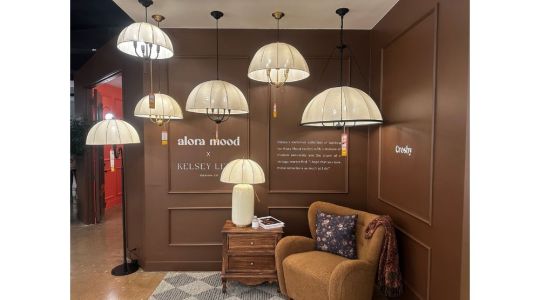
Alora introduced the Alora Mood X Kelsey Leigh collection, featuring the softened looks prevalent at Lightovation 2025. DALLAS — Many lighting manufacturers came to Lightovation earlier this month with a more practical, realistic mindset, acknowledging with their product intros that in 2025, many consumers may not have a big budget for lighting nor a grand space in which to install it. They are therefore paying more attention to smaller spaces, renters and affordable lighting options with design-forward pieces that rival their larger and more expensive cousins. In addition, the humble ceiling fan seems to be having a bit of a resurgence, and outdoor lighting options increased. If the Trump administration’s proposed tariffs become reality, lighting prices will increase, said Jeff Dross. Dross, an industry expert who was a corporate director of education and industry trends at Kichler Lighting for over 46 years, spoke during an American Society of Interior Designers (ASID) panel discussion during market. An ASID panel discussion covered trending topics in lighting. This is something most vendors have acknowledged since the issue of tariffs was first raised during the presidential campaign last year. Many of them pointed out that almost every company in the industry will be forced to raise prices and thus no one manufacturer will stand out. Dross, however, noted that “something will have to give” and manufacturers may find themselves less able to support their retail partners with things like product images and other assets, or may have to take more drastic steps such as reducing staff, relocating their business to a more affordable location or moving to smaller buildings. In the same panel discussion, Kirsten Recce of Black Whale Home in Encinitas, Calif., noted that the industry is still sitting on the 25% increase that results from the 2017 tariffs. “Lighting prices have essentially doubled in the past eight years,” Recce said. “On the lighting showroom side, I’m not seeing the budget for lighting that I used to see. I am seeing a saturation point … it’s getting harder and harder to sell high-end lighting. It’s the more value-oriented lines [that are selling.] “Both the lighting designer and the retail customer is stepping down.” Smaller spaces Perhaps with that in mind, manufacturers are paying more attention to smaller living spaces and apartment rentals (albeit higher-end apartment rentals) with lighting that can plug in — versus having to be hardwired — and trend-forward semi-flush and flush-mounts that are ideal for the 8- and 10-foot ceilings more commonly found in older homes and apartments. Knowing that consumer budgets are likely to dictate lighting choices this year, some vendors suggested that interior designers and end consumers could highlight one higher-end fixture in the most prominent or visited room in a home and use more budget-friendly choices that complement the higher-end fixture in the less-used or less-seen rooms. This also takes into consideration that consumers often only consider lighting with their leftover money, after all other room renovations are done. There was also a resurgent focus among manufacturers in ceiling fans, with more options from Maxim Lighting and Kuzco, among others, and a continued large offering from WAC Lighting and Progress Lighting, among others. Alex Ostrovsky, director of sales and product management for WAC Group, said the company was trying to get interior designers to better appreciate ceiling fans with models that are sleek and subtle, disappear into the space and “don’t clutter the ceiling.” Its carved balsa wood fans have been a popular sub-category of fans for the past four or five years, he said. Michael Poole of Visual Comfort shows off the Plank ceiling fan. At Visual Comfort, fans “have to perform and be beautiful,” said Michael Poole, senior manager for design partnerships and a former product developer. “The motor has to be powerful, sleek, quiet and move air. We invest in all those things.” Outdoor lighting Outdoor lighting designs also had their place in the spotlight at Lightovation. Industry newcomer Alteck Lighting made its Lightovation debut with a large assortment of outdoor styles with color-changing capability in a range of materials, all of which are 100% wet-location rated, according to Colleen Visage, chief operating officer. Alteck’s Eclipse flush mount, left, and the Raymond sconce Hubbardton Forge offered its take on traditional outdoor designs with a new shepherd’s hook-style lantern and one that had a cloche-like cover, rather than the panel-sided design. Many pieces in its outdoor assortment are Dark Sky-friendly, with no upward “escape” of light. Troy Lighting, part of the Hudson Valley Lighting Group, featured damp-rated rechargeable outdoor lanterns, its first foray into the outdoor cordless lamp category. Kichler, some of whose products were featured in its new corporate sister Progress Lighting’s showroom, has an Landscape Lighting Lab in its Experience Center in Dallas. Maxim noted its proprietary and patented Vivex material, which can withstand salt water, heat and cold, making it appropriate for coastal environments. It has a three-year limited warranty. Design direction “Softening” was the term most frequently used to describe an emerging design aesthetic, a blurring of style lines that makes looks more broadly appealing. So, contemporary or modern designs are softened using things like fabric shades, opaque glass or more classic elements, such as paneled sides or parasol shapes. The bare bulb era seems to be over. Bulbs took a backseat to shades which are milky, swirled and made of opaque white glass. There were more linen or fabric shades spotted at this show, more ribbed and fluted glass shades, and more diffusers. Natural materials like rattan have become a mainstay, and light-colored woods are on the rise, matching current looks in flooring and cabinetry, some vendors noted. The Ellen DeGeneres Hikari linen pendant from Visual Comfort’s Studio line, left, and Lisa McDennon’s fringed Baya pendant from Hinkley There is a need for color, retailer Recce said. “Every shelter magazine is screaming color, and our industry has never had less color,” she said. There were touches here and there, including art glass pendants from Fine Art Handcrafted Lighting, Crystorama and Maxim Lighting, as well as colorful metal pendants with neutral undertones from Kuzco. Among the more interesting materials and material combinations at market was Maxim’s pendants designed by Ryan Saghian and made from perforated metal dipped in plaster and paired with travertine. !function(f,b,e,v,n,t,s) if(f.fbq)return;n=f.fbq=function()n.callMethod? n.callMethod.apply(n,arguments):n.queue.push(arguments); if(!f._fbq)f._fbq=n;n.push=n;n.loaded=!0;n.version='2.0'; n.queue=[];t=b.createElement(e);t.async=!0; t.src=v;s=b.getElementsByTagName(e)[0]; s.parentNode.insertBefore(t,s)(window, document,'script', ' fbq('init', '693453330863834'); fbq('track', 'PageView'); Source link
#HOME_DECOR#ACCENTS#ALTECK_LIGHTING#ASID#DALLAS#DESIGN#DIRECTIONS#HINKLEY_LIGHTING#HOME#JEFF_DROSS#KICHLER#KUZCO#LIGHTOVATION#MAXIM_LIGHTING#PROGRESS_LIGHTING#TODAY#TROY_LIGHTING#VISUAL_COMFORT#WAC_GROUP
0 notes
Photo
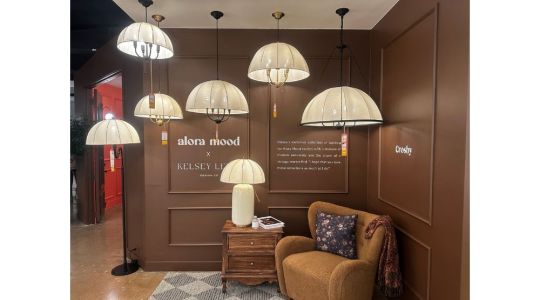
Alora introduced the Alora Mood X Kelsey Leigh collection, featuring the softened looks prevalent at Lightovation 2025. DALLAS — Many lighting manufacturers came to Lightovation earlier this month with a more practical, realistic mindset, acknowledging with their product intros that in 2025, many consumers may not have a big budget for lighting nor a grand space in which to install it. They are therefore paying more attention to smaller spaces, renters and affordable lighting options with design-forward pieces that rival their larger and more expensive cousins. In addition, the humble ceiling fan seems to be having a bit of a resurgence, and outdoor lighting options increased. If the Trump administration’s proposed tariffs become reality, lighting prices will increase, said Jeff Dross. Dross, an industry expert who was a corporate director of education and industry trends at Kichler Lighting for over 46 years, spoke during an American Society of Interior Designers (ASID) panel discussion during market. An ASID panel discussion covered trending topics in lighting. This is something most vendors have acknowledged since the issue of tariffs was first raised during the presidential campaign last year. Many of them pointed out that almost every company in the industry will be forced to raise prices and thus no one manufacturer will stand out. Dross, however, noted that “something will have to give” and manufacturers may find themselves less able to support their retail partners with things like product images and other assets, or may have to take more drastic steps such as reducing staff, relocating their business to a more affordable location or moving to smaller buildings. In the same panel discussion, Kirsten Recce of Black Whale Home in Encinitas, Calif., noted that the industry is still sitting on the 25% increase that results from the 2017 tariffs. “Lighting prices have essentially doubled in the past eight years,” Recce said. “On the lighting showroom side, I’m not seeing the budget for lighting that I used to see. I am seeing a saturation point … it’s getting harder and harder to sell high-end lighting. It’s the more value-oriented lines [that are selling.] “Both the lighting designer and the retail customer is stepping down.” Smaller spaces Perhaps with that in mind, manufacturers are paying more attention to smaller living spaces and apartment rentals (albeit higher-end apartment rentals) with lighting that can plug in — versus having to be hardwired — and trend-forward semi-flush and flush-mounts that are ideal for the 8- and 10-foot ceilings more commonly found in older homes and apartments. Knowing that consumer budgets are likely to dictate lighting choices this year, some vendors suggested that interior designers and end consumers could highlight one higher-end fixture in the most prominent or visited room in a home and use more budget-friendly choices that complement the higher-end fixture in the less-used or less-seen rooms. This also takes into consideration that consumers often only consider lighting with their leftover money, after all other room renovations are done. There was also a resurgent focus among manufacturers in ceiling fans, with more options from Maxim Lighting and Kuzco, among others, and a continued large offering from WAC Lighting and Progress Lighting, among others. Alex Ostrovsky, director of sales and product management for WAC Group, said the company was trying to get interior designers to better appreciate ceiling fans with models that are sleek and subtle, disappear into the space and “don’t clutter the ceiling.” Its carved balsa wood fans have been a popular sub-category of fans for the past four or five years, he said. Michael Poole of Visual Comfort shows off the Plank ceiling fan. At Visual Comfort, fans “have to perform and be beautiful,” said Michael Poole, senior manager for design partnerships and a former product developer. “The motor has to be powerful, sleek, quiet and move air. We invest in all those things.” Outdoor lighting Outdoor lighting designs also had their place in the spotlight at Lightovation. Industry newcomer Alteck Lighting made its Lightovation debut with a large assortment of outdoor styles with color-changing capability in a range of materials, all of which are 100% wet-location rated, according to Colleen Visage, chief operating officer. Alteck’s Eclipse flush mount, left, and the Raymond sconce Hubbardton Forge offered its take on traditional outdoor designs with a new shepherd’s hook-style lantern and one that had a cloche-like cover, rather than the panel-sided design. Many pieces in its outdoor assortment are Dark Sky-friendly, with no upward “escape” of light. Troy Lighting, part of the Hudson Valley Lighting Group, featured damp-rated rechargeable outdoor lanterns, its first foray into the outdoor cordless lamp category. Kichler, some of whose products were featured in its new corporate sister Progress Lighting’s showroom, has an Landscape Lighting Lab in its Experience Center in Dallas. Maxim noted its proprietary and patented Vivex material, which can withstand salt water, heat and cold, making it appropriate for coastal environments. It has a three-year limited warranty. Design direction “Softening” was the term most frequently used to describe an emerging design aesthetic, a blurring of style lines that makes looks more broadly appealing. So, contemporary or modern designs are softened using things like fabric shades, opaque glass or more classic elements, such as paneled sides or parasol shapes. The bare bulb era seems to be over. Bulbs took a backseat to shades which are milky, swirled and made of opaque white glass. There were more linen or fabric shades spotted at this show, more ribbed and fluted glass shades, and more diffusers. Natural materials like rattan have become a mainstay, and light-colored woods are on the rise, matching current looks in flooring and cabinetry, some vendors noted. The Ellen DeGeneres Hikari linen pendant from Visual Comfort’s Studio line, left, and Lisa McDennon’s fringed Baya pendant from Hinkley There is a need for color, retailer Recce said. “Every shelter magazine is screaming color, and our industry has never had less color,” she said. There were touches here and there, including art glass pendants from Fine Art Handcrafted Lighting, Crystorama and Maxim Lighting, as well as colorful metal pendants with neutral undertones from Kuzco. Among the more interesting materials and material combinations at market was Maxim’s pendants designed by Ryan Saghian and made from perforated metal dipped in plaster and paired with travertine. !function(f,b,e,v,n,t,s) if(f.fbq)return;n=f.fbq=function()n.callMethod? n.callMethod.apply(n,arguments):n.queue.push(arguments); if(!f._fbq)f._fbq=n;n.push=n;n.loaded=!0;n.version='2.0'; n.queue=[];t=b.createElement(e);t.async=!0; t.src=v;s=b.getElementsByTagName(e)[0]; s.parentNode.insertBefore(t,s)(window, document,'script', ' fbq('init', '693453330863834'); fbq('track', 'PageView'); Source link
#HOME_DECOR#ACCENTS#ALTECK_LIGHTING#ASID#DALLAS#DESIGN#DIRECTIONS#HINKLEY_LIGHTING#HOME#JEFF_DROSS#KICHLER#KUZCO#LIGHTOVATION#MAXIM_LIGHTING#PROGRESS_LIGHTING#TODAY#TROY_LIGHTING#VISUAL_COMFORT#WAC_GROUP
0 notes